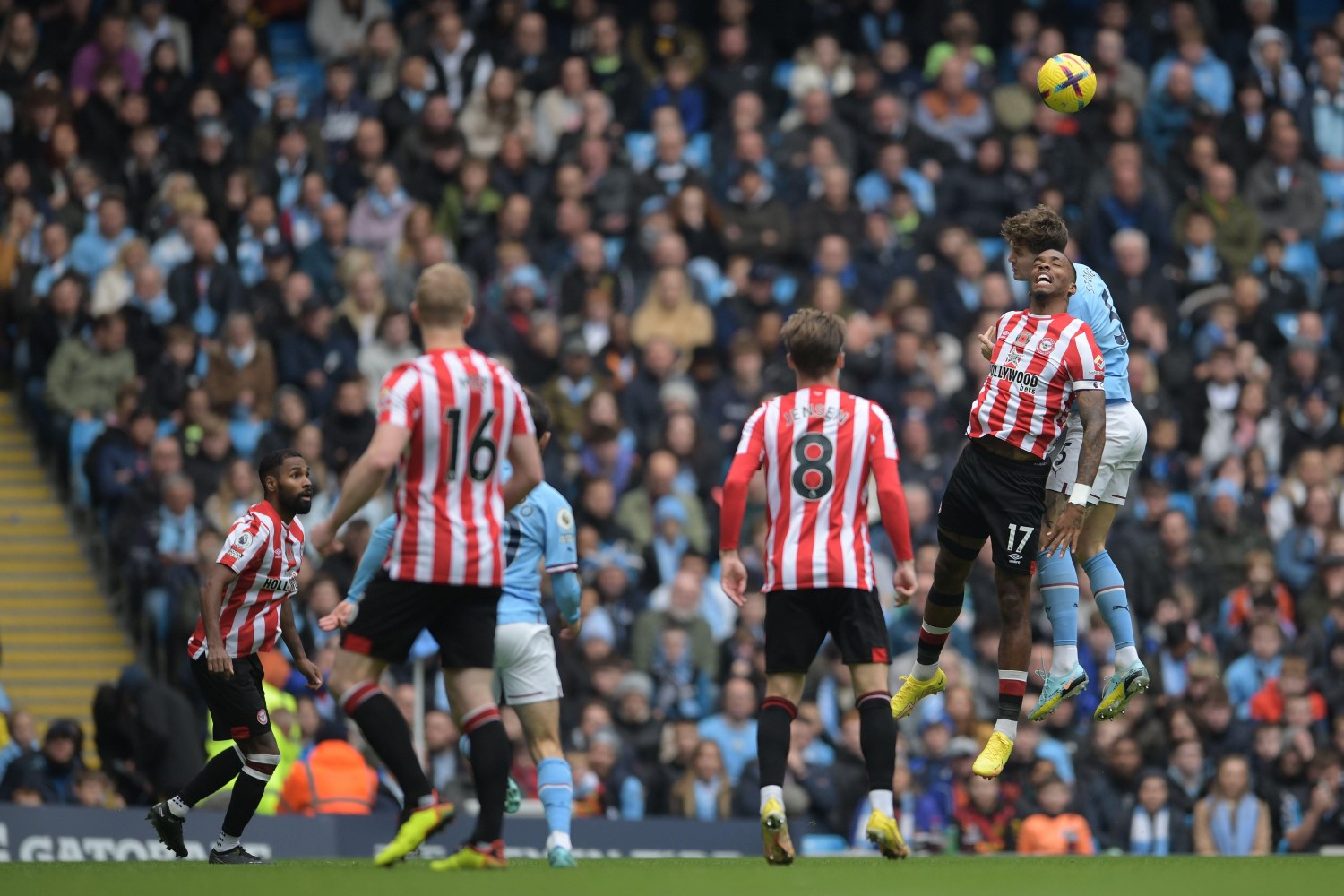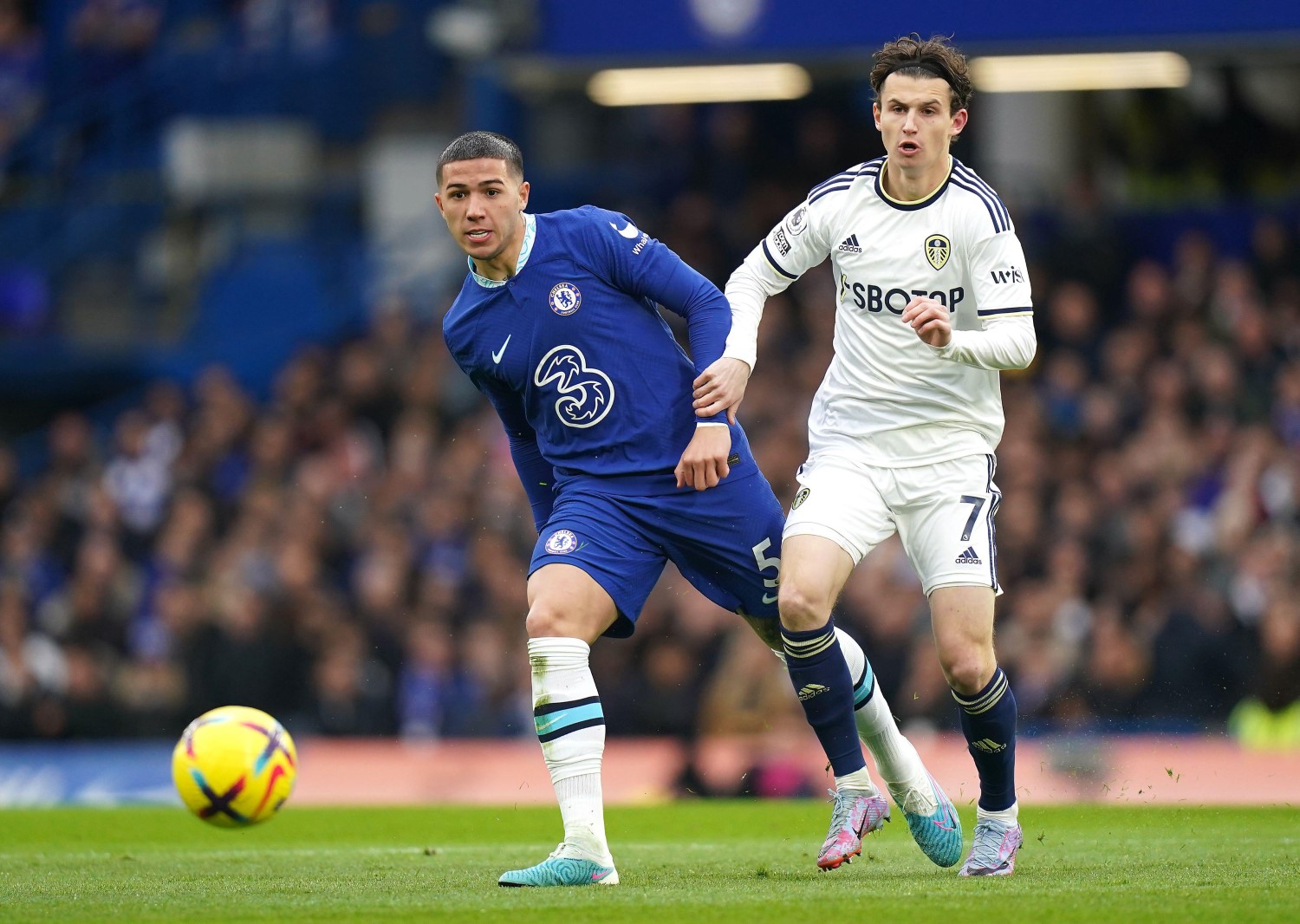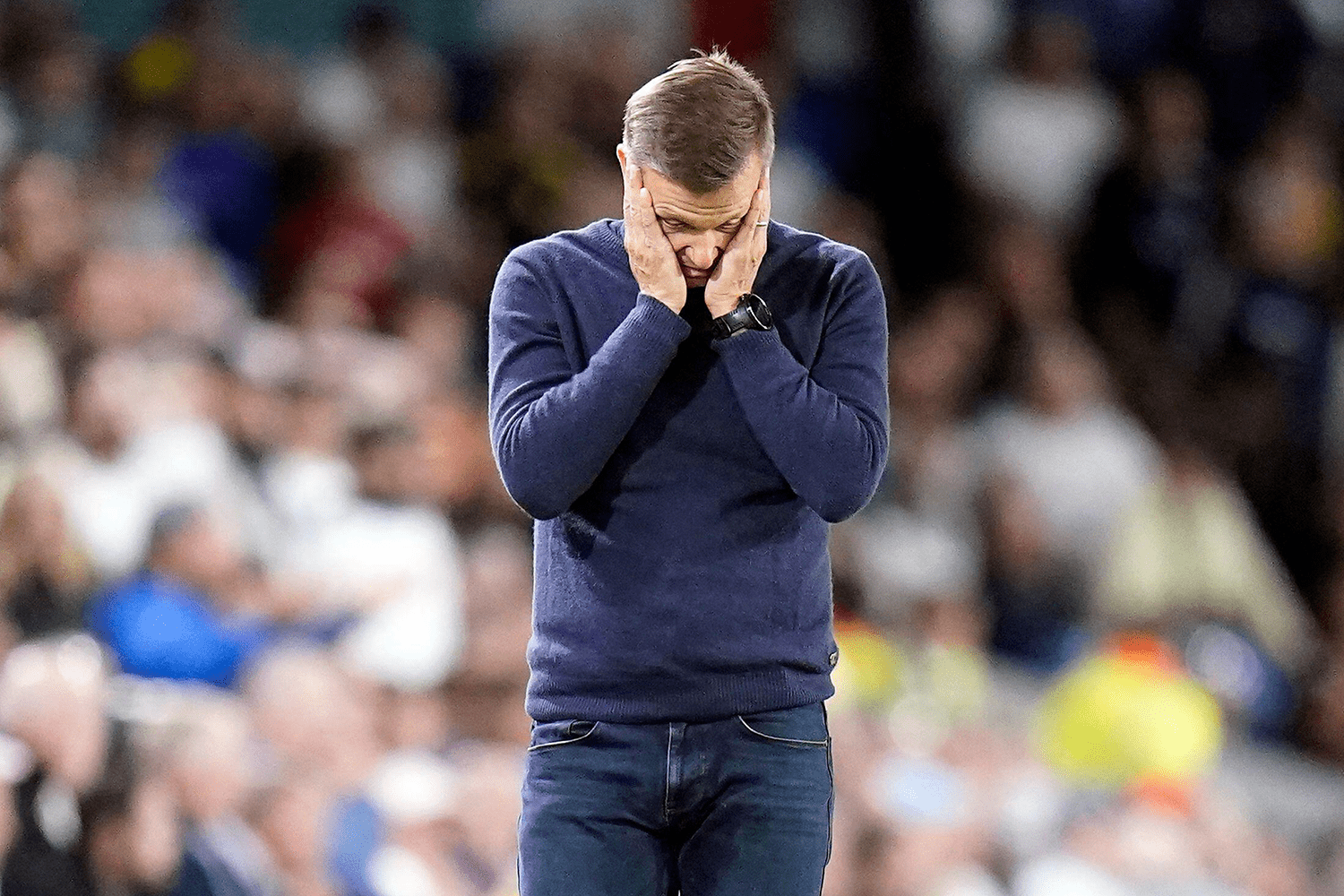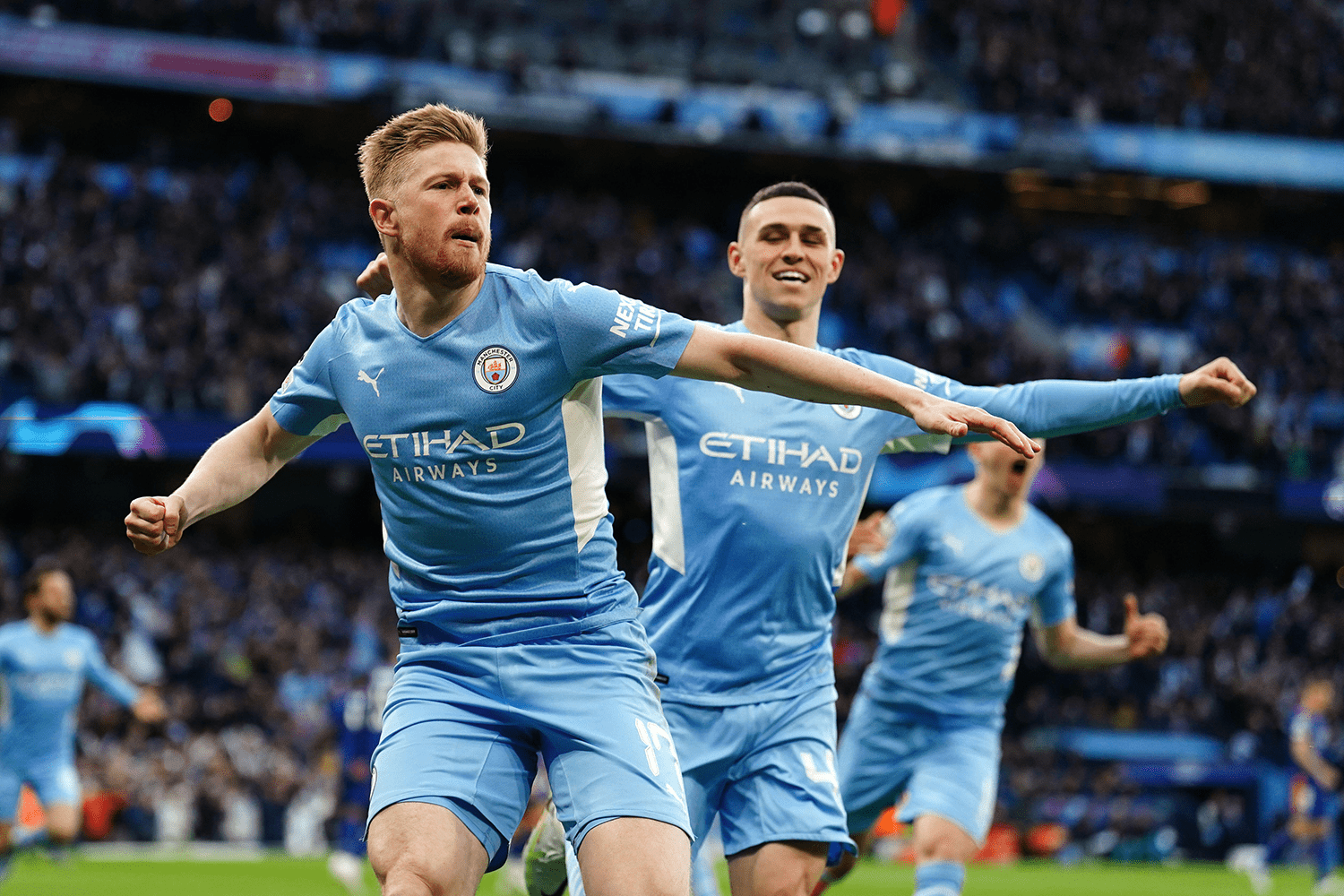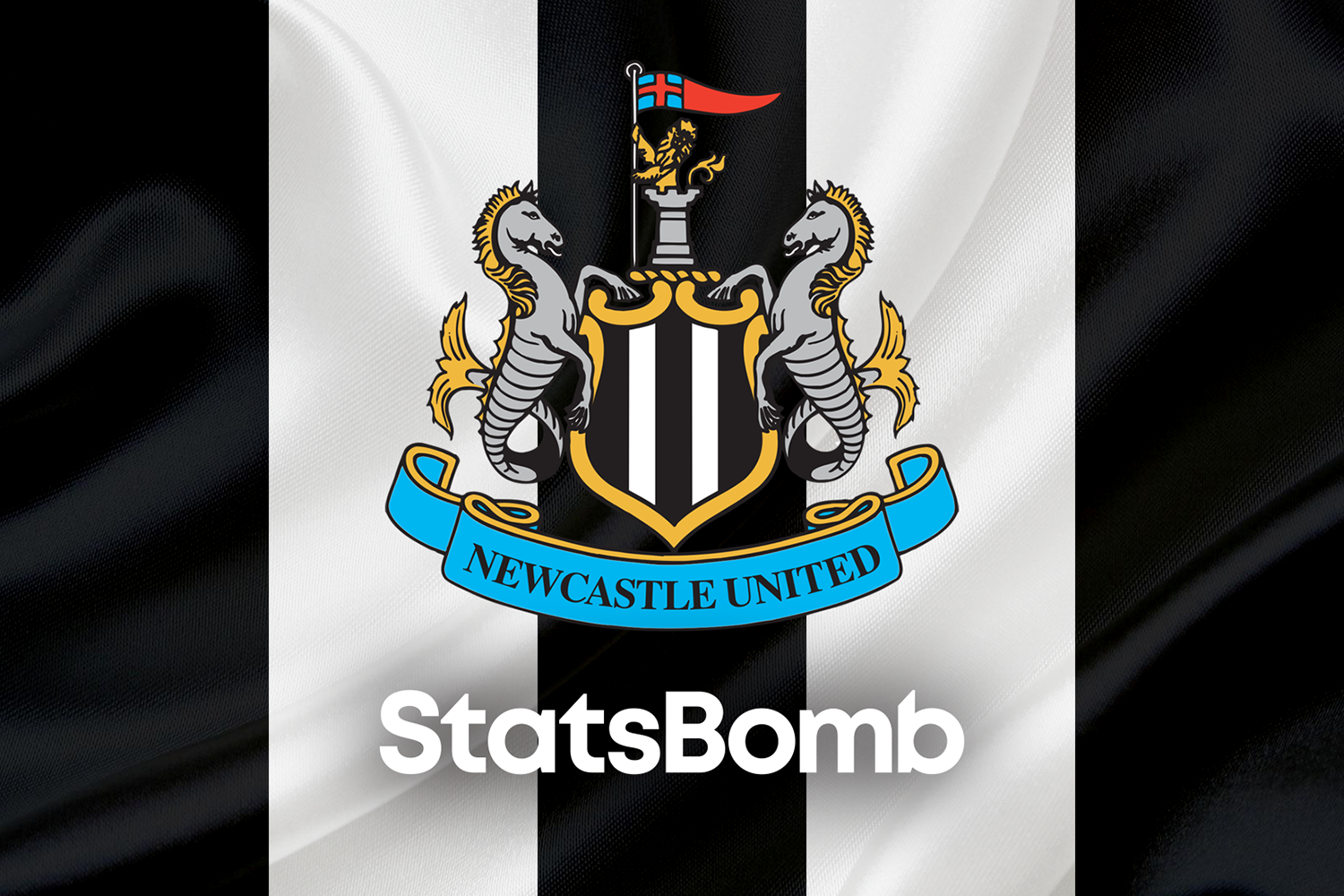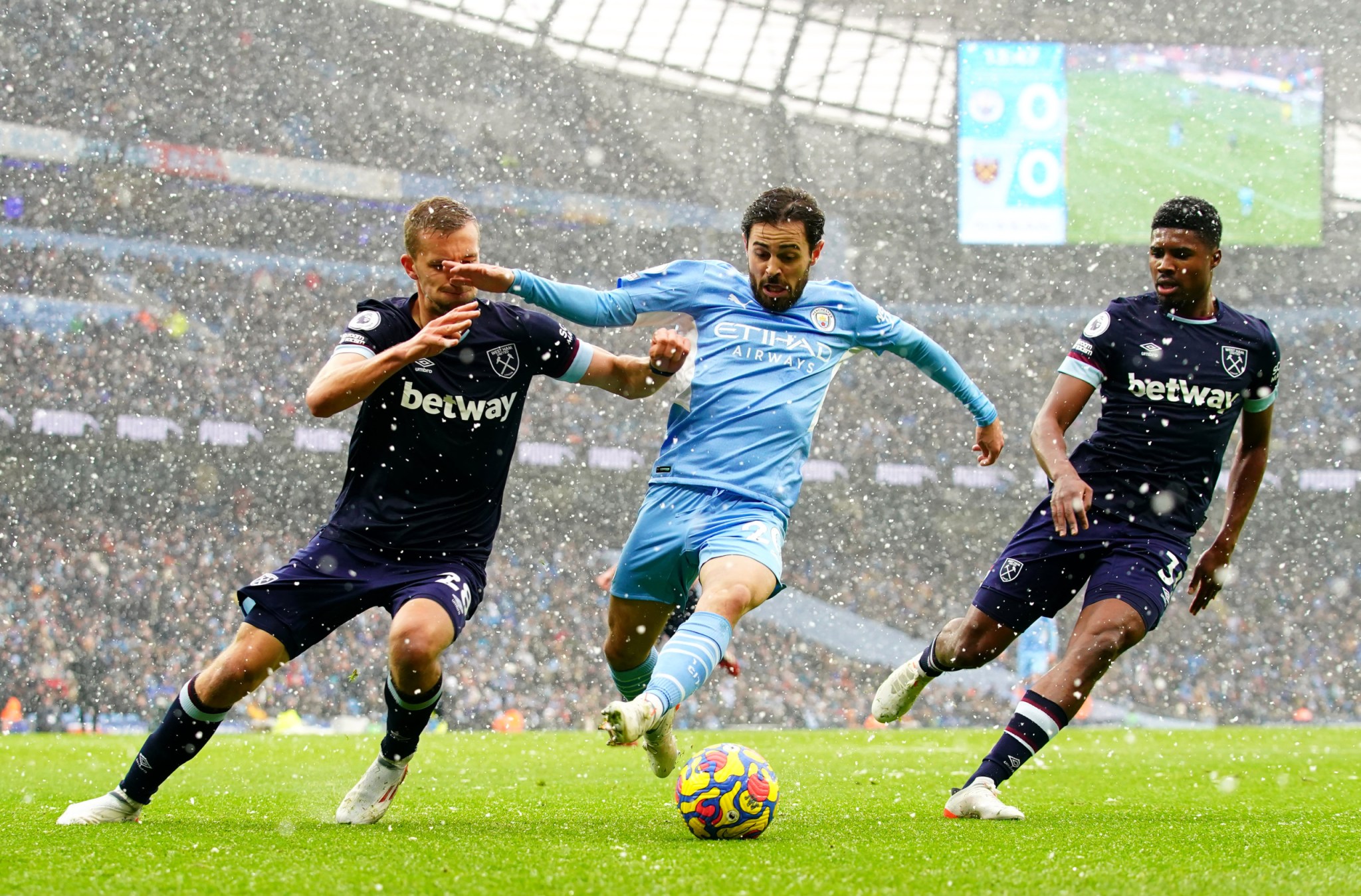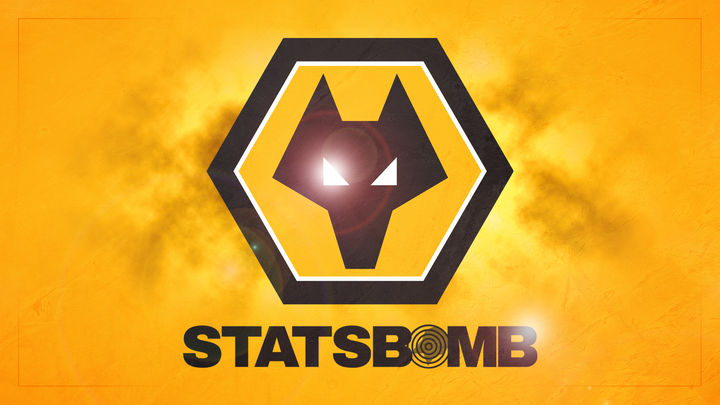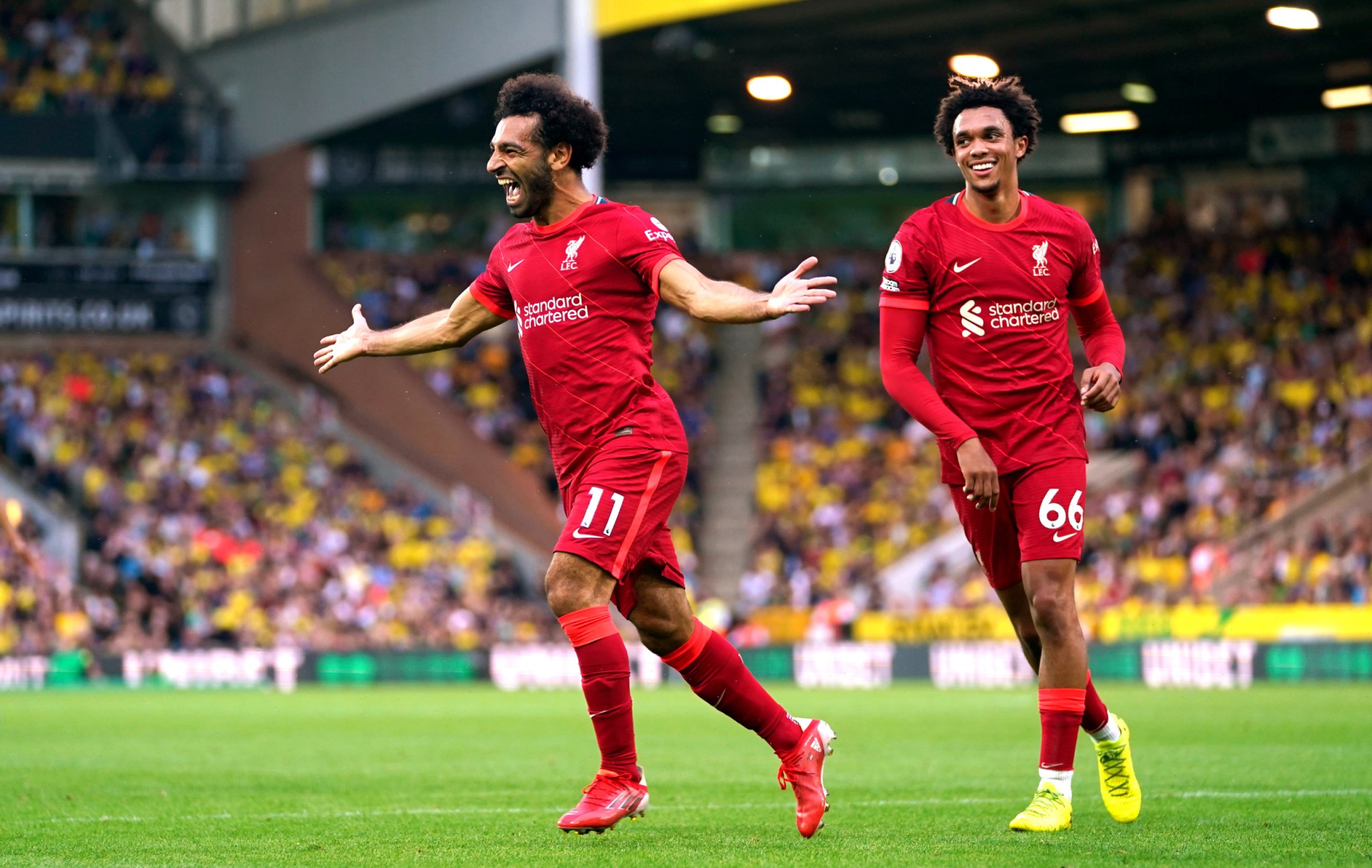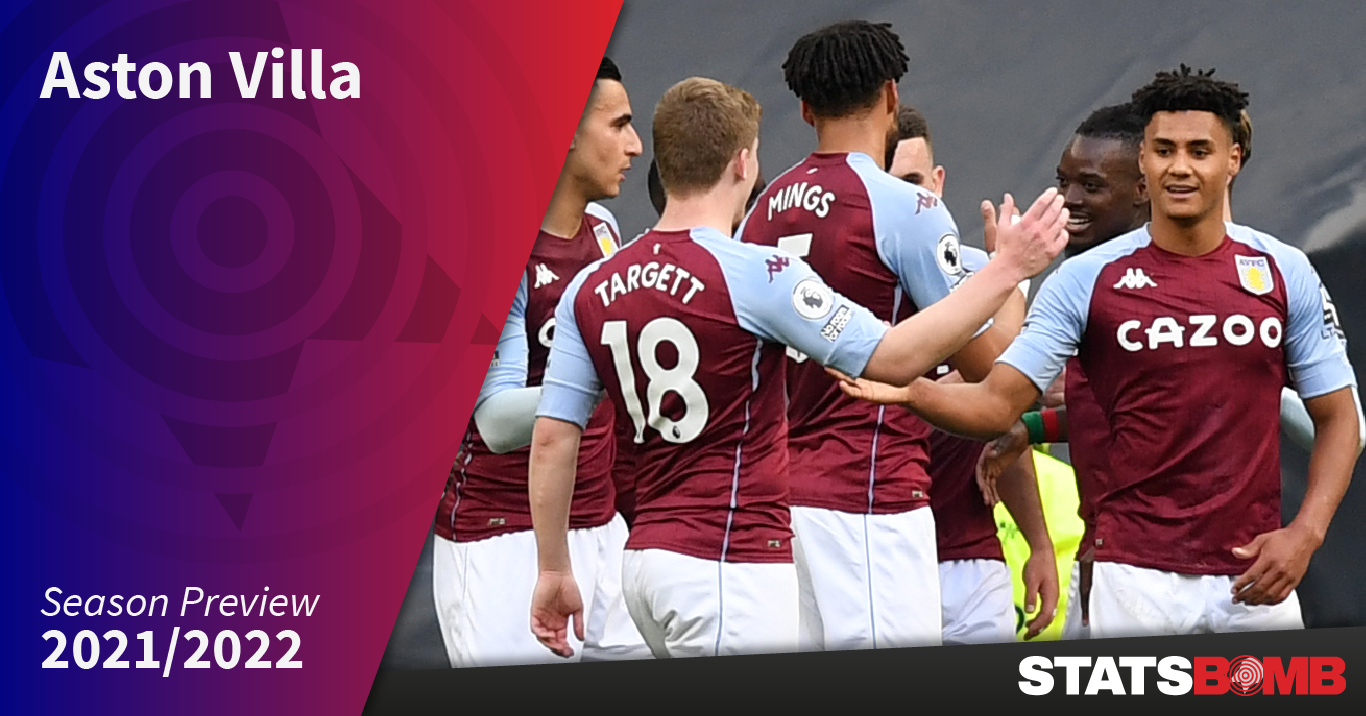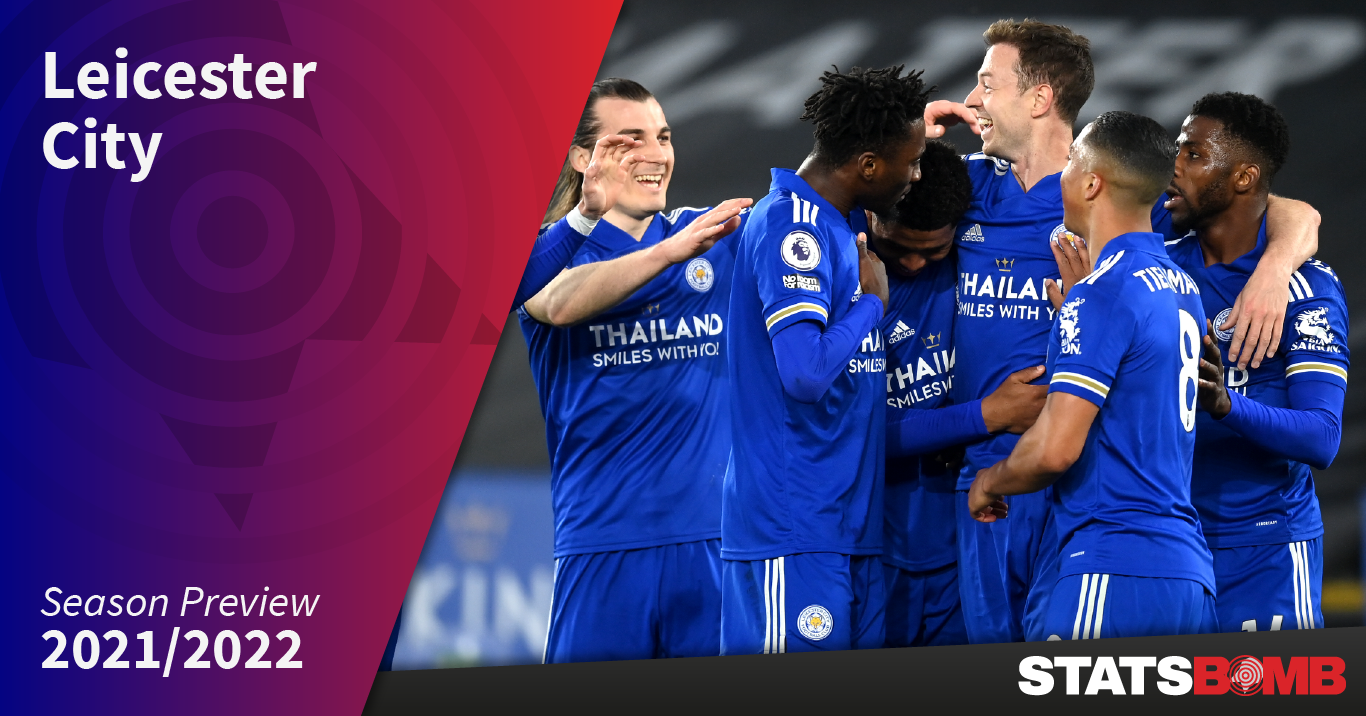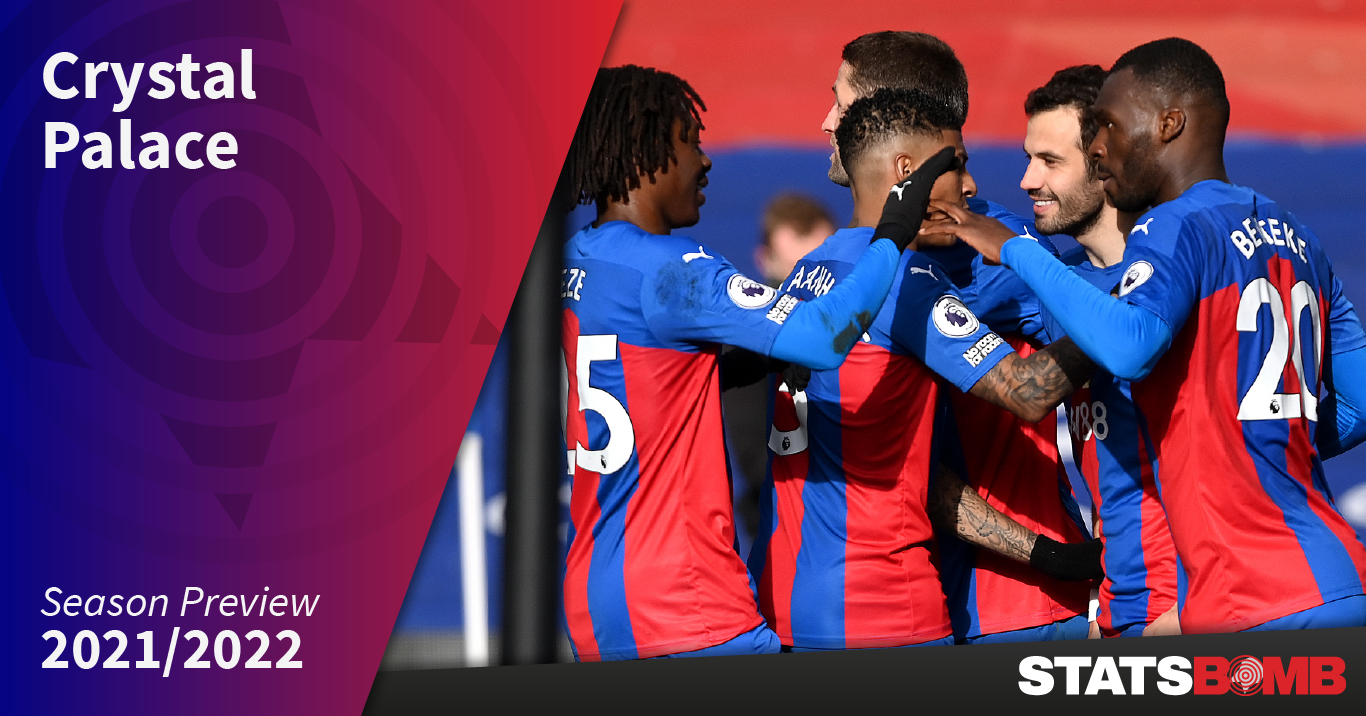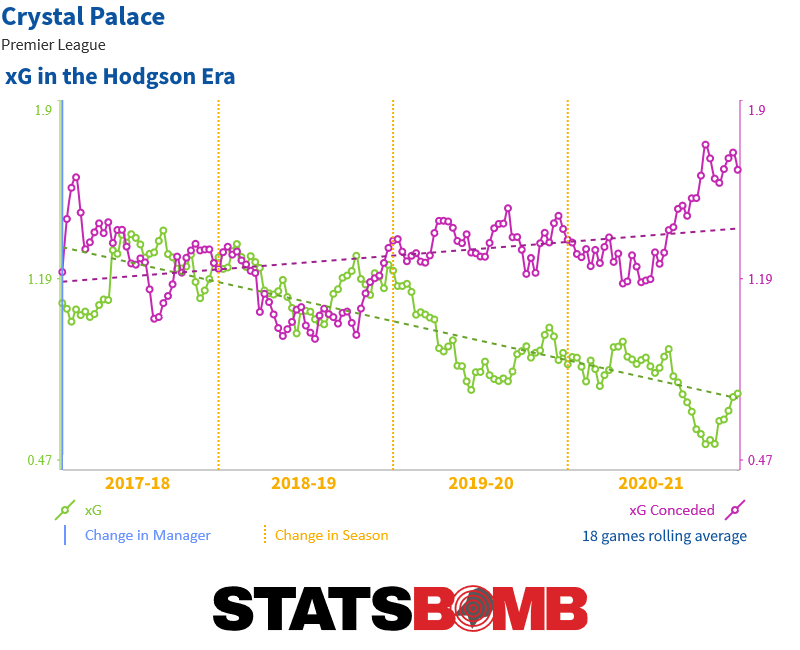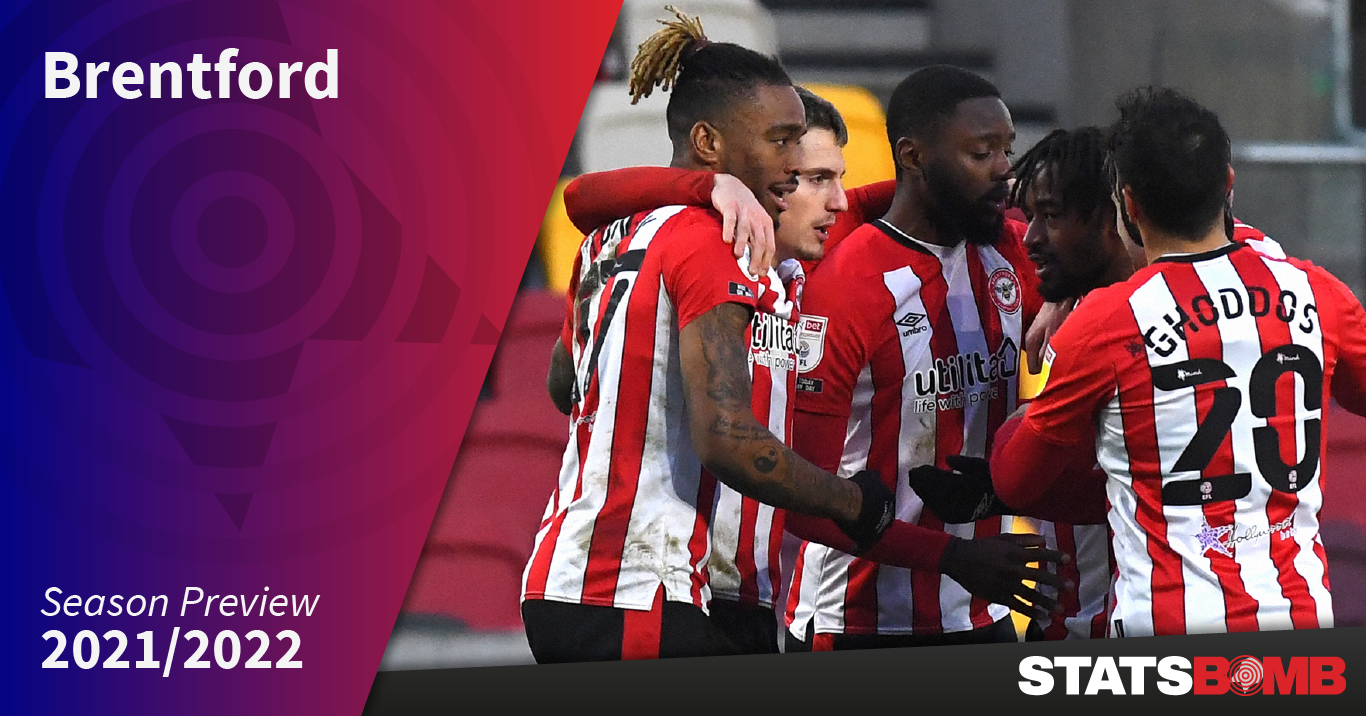Wolverhampton Wanderers FC has signed a multi-year deal with StatsBomb to use its data and analytics services. This agreement demonstrates the club's ambition to build upon its recent European and domestic successes by utilising deep data and innovative platforms in its recruitment and performance analysis departments. As part of the agreement, the English Premier League club has also become the latest elite team to sign up for StatsBomb 360, a product crafted at the forefront of innovation in football analytics. StatsBomb 360 adds a snapshot of player locations around every on-the-ball event during a match. The StatsBomb 360 data will enable Wolves to easily analyse its defensive shape, available passing lanes and decision-making, ball receipts in space, line-breaking passes and much more. Wolves will also have access to StatsBomb's market-leading core data set and StatsBomb IQ platform. The performance data includes a number of unique metrics such as pressures by player and team, pass footedness and shot impact height. The StatsBomb IQ platform will enhance the club's recruitment and opposition analysis capabilities by making it easier to find suitable players via customisable templates and unearth patterns in its opponents' play. Shergul Arshad, Chief Commercial Officer, StatsBomb, said: "We are thrilled to be working with Wolverhampton Wanderers. The Premier League is fiercely competitive. By choosing StatsBomb as its data and analytics supplier, the Wolves scouting team has the best tools to find players across a wide range of leagues, and its match analysts have unparalleled data to evaluate opponents." Speaking about the agreement, Mathew Pearson, Head of Performance and Research, Wolverhampton Wanderers FC, said: "At Wolves we constantly look to be innovative and progressive and to embrace new ideas and technologies. The addition of StatsBomb has allowed us to further integrate data into both our analysis and recruitment work flows and has been a valuable asset to both”
Sorry to keep you waiting, Villa fans. There’s been a lot to evaluate. The club made big forward strides last season, strides so big that most people forgot all about the anxious last-day wait Villa had to endure just to maintain their Premier League status at the end of 2019/20. Now established in midtable, the club faces a new challenge. Before we get into the summer’s events and where that leaves Villa in the short and medium-term, let’s take a quick look back on the 2020/21 season as a whole. Surviving by a single point the season before, the Villains added a whopping 20 points to their tally to finish comfortable in 11th place, a full ten points ahead of Newcastle in 12th. This wasn’t just keeping relegation at arm's length but shoving it out of sight and out of mind. An improvement in the on-pitch performances powered the leap up the table: Villa turned a near-league-worst expected goal difference, -0.62 xGD per game, into a comfortable midtable process, bang on +0 xGD per game over the whole season. 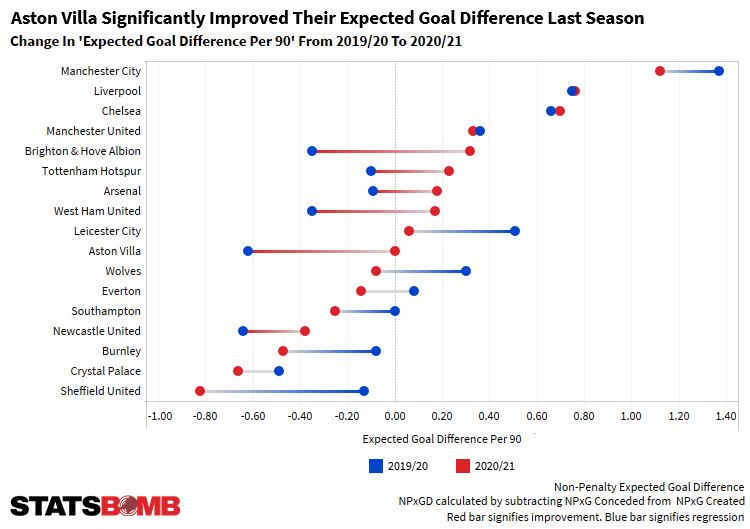 They improved at both ends of the pitch, adding 0.28 xG per game onto the attack (~10 goals a season) and shaving -0.34 xG per game off the defence (~13 goals a season). At the back, they conceded fewer shots (15.8 – 14.1) that were of a worse quality measured by xG per shot (0.10 – 0.09). They were defending better as a collective, with goalkeeper Emiliano Martínez having a stellar season when the opposition did manage to create an attempt on goal. Digging into what they did to limit the opposition, it becomes clear that Villa started to protect the goal more effectively, defending their penalty box with more bodies and a greater emphasis on making it difficult for the opposition to score. The team became more balanced and more challenging to break down – they forced their opponents average shot distance back by more than a metre, 15.8m in 2019/20 versus 16.9m in 2020/21. A difference that sounds small, but their opposition shots were 6th-closest in the league before and 17th-closest after. Besides being more difficult to break down, they also effectively prevented the opposition from getting a clear sight of goal. Villa averaged the most defenders behind the ball when their opponents took a footed shot in the box, and the most defenders between ball and goal in the same circumstances. Naturally, they also had one of the best block rates of those same shots. You can’t concede goals if the ball doesn’t test the ‘keeper in the first place.
They improved at both ends of the pitch, adding 0.28 xG per game onto the attack (~10 goals a season) and shaving -0.34 xG per game off the defence (~13 goals a season). At the back, they conceded fewer shots (15.8 – 14.1) that were of a worse quality measured by xG per shot (0.10 – 0.09). They were defending better as a collective, with goalkeeper Emiliano Martínez having a stellar season when the opposition did manage to create an attempt on goal. Digging into what they did to limit the opposition, it becomes clear that Villa started to protect the goal more effectively, defending their penalty box with more bodies and a greater emphasis on making it difficult for the opposition to score. The team became more balanced and more challenging to break down – they forced their opponents average shot distance back by more than a metre, 15.8m in 2019/20 versus 16.9m in 2020/21. A difference that sounds small, but their opposition shots were 6th-closest in the league before and 17th-closest after. Besides being more difficult to break down, they also effectively prevented the opposition from getting a clear sight of goal. Villa averaged the most defenders behind the ball when their opponents took a footed shot in the box, and the most defenders between ball and goal in the same circumstances. Naturally, they also had one of the best block rates of those same shots. You can’t concede goals if the ball doesn’t test the ‘keeper in the first place. 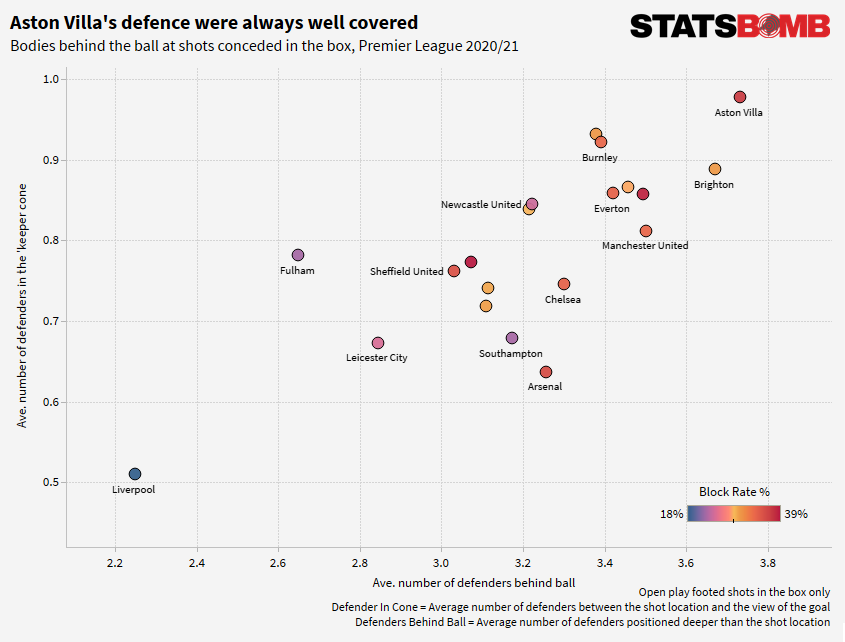 As good as the improvement was, Villa struggled in the second half of the season. They closed the season with a 4-4-6 record to take just 16 points from 14 games, worth 43 points when extrapolated over the whole season, solid bottom-half form. It could be an indicator of what may come next season, with the run coinciding with the injury to *klaxon* Jack Grealish (I made it this far without saying his name), but even with signings brought in to replace him, there was still a worrying decline in the underlying numbers. Both defence and attack got worse.
As good as the improvement was, Villa struggled in the second half of the season. They closed the season with a 4-4-6 record to take just 16 points from 14 games, worth 43 points when extrapolated over the whole season, solid bottom-half form. It could be an indicator of what may come next season, with the run coinciding with the injury to *klaxon* Jack Grealish (I made it this far without saying his name), but even with signings brought in to replace him, there was still a worrying decline in the underlying numbers. Both defence and attack got worse. 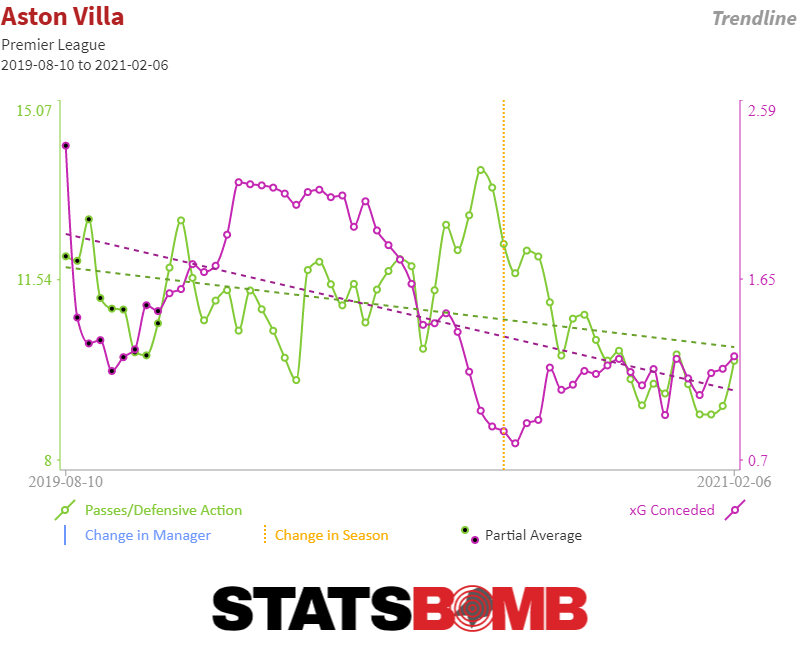 Right then, let’s hang around no longer. Time to address the big question that everyone’s asking. How will Villa cope without Jack Grealish? A look at Villa’s most common build-up patterns has the thick-calved Brummie’s footprints all over them. Nearly all of their play was filtered down the left-hand side where Grealish would situate and perform his best work, combining with Ollie Watkins and Matt Targett and laying on chances for his teammates.
Right then, let’s hang around no longer. Time to address the big question that everyone’s asking. How will Villa cope without Jack Grealish? A look at Villa’s most common build-up patterns has the thick-calved Brummie’s footprints all over them. Nearly all of their play was filtered down the left-hand side where Grealish would situate and perform his best work, combining with Ollie Watkins and Matt Targett and laying on chances for his teammates. 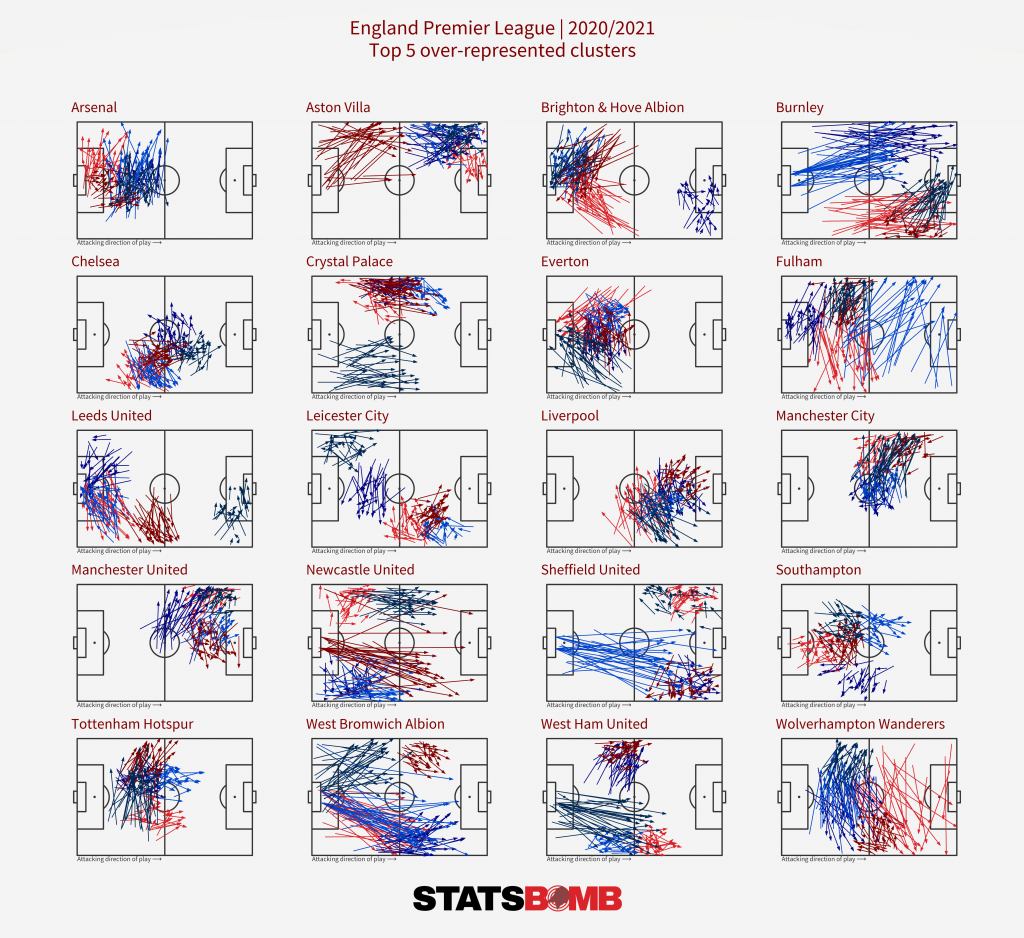
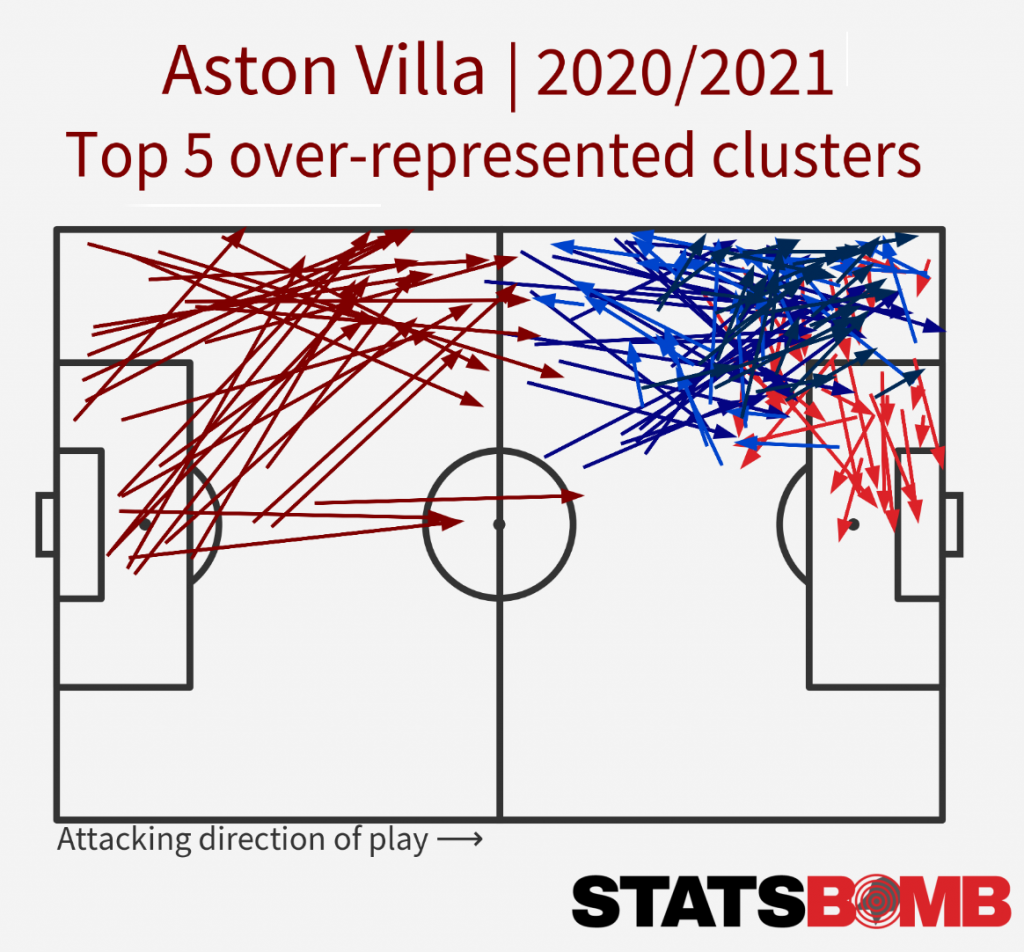 Grealish was on a different level to his teammates last season, and indeed most of the Premier League. Our new possession value model, On-Ball Value, assigns a positive or negative value to each action performed on the pitch based on its impact on a team’s chances of scoring or conceding. Players such as Kevin De Bruyne, Trent Alexander-Arnold, and Mohamed Salah all performed well by this measure. Guess who topped the league?
Grealish was on a different level to his teammates last season, and indeed most of the Premier League. Our new possession value model, On-Ball Value, assigns a positive or negative value to each action performed on the pitch based on its impact on a team’s chances of scoring or conceding. Players such as Kevin De Bruyne, Trent Alexander-Arnold, and Mohamed Salah all performed well by this measure. Guess who topped the league? 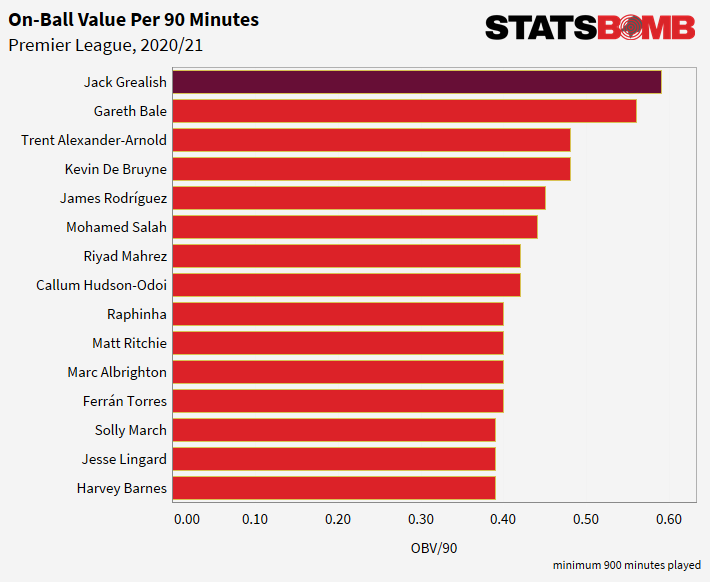 Looking purely at chance creation output metrics, Grealish’s importance to Villa’s attacking play becomes apparent. He was responsible for an overwhelming portion of their chance creation – 23% of Villa’s assisted xG was created by Grealish – and he was also responsible for taking 9% of their xG himself, behind only Ollie Watkins, Bertrand Traoré and Anwar El Ghazi.
Looking purely at chance creation output metrics, Grealish’s importance to Villa’s attacking play becomes apparent. He was responsible for an overwhelming portion of their chance creation – 23% of Villa’s assisted xG was created by Grealish – and he was also responsible for taking 9% of their xG himself, behind only Ollie Watkins, Bertrand Traoré and Anwar El Ghazi. 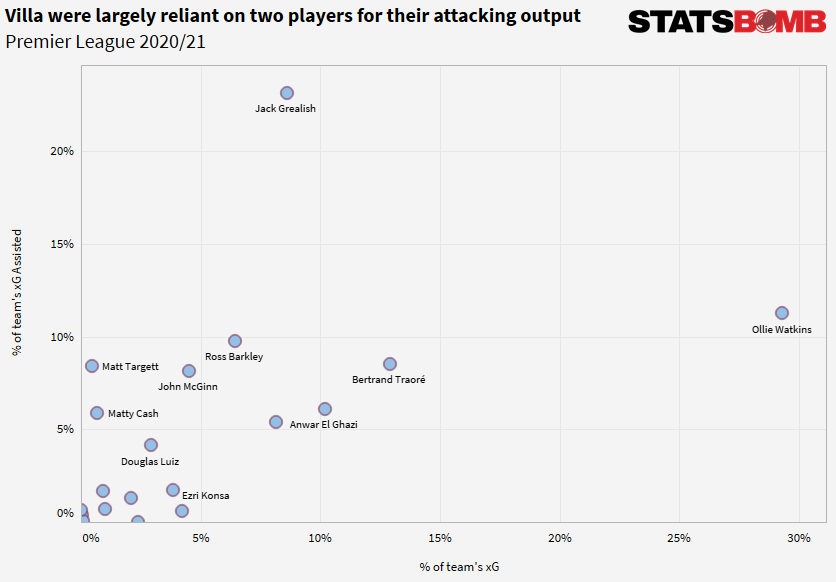 The scatterplot highlights the need for Villa to become less reliant on Grealish – of which they have no choice – and Ollie Watkins, with Watkins responsible for 29% of Villa’s xG. It’s not unusual for a team to have a focal point who finishes most of their chances, but it does leave them in a precarious position without a) adequate contributions from elsewhere in the team and b) quality backup should Watkins get injured. Upon Grealish’s nine-figure sale to Manchester City, Villa CEO Christian Purslow published a statement that specifically addressed the transfer. In the statement, he said:
The scatterplot highlights the need for Villa to become less reliant on Grealish – of which they have no choice – and Ollie Watkins, with Watkins responsible for 29% of Villa’s xG. It’s not unusual for a team to have a focal point who finishes most of their chances, but it does leave them in a precarious position without a) adequate contributions from elsewhere in the team and b) quality backup should Watkins get injured. Upon Grealish’s nine-figure sale to Manchester City, Villa CEO Christian Purslow published a statement that specifically addressed the transfer. In the statement, he said:
“It was never our intention to replace Jack with one footballer. Our strategy was to analyse and break down Jack’s key attributes - his creativity, his assists, and his goals - and to find these qualities, and others, in three forward players.”
In come Danny Ings from Southampton, Leon Bailey from Bayer Leverkusen, and Emi Buendía from Norwich. By bringing Buendía in, Villa have in many ways done to Norwich what Manchester City have done to them. Buendía was the creative hub at Norwich, a player that stood out above the rest, and was responsible for a very similar amount of Norwich’s output, with 22% of Norwich xG Assisted coming through the Argentine and 16% of their xG. It’s not just in the final third that Buendía can do it though. He was one of the most active defenders in the Championship last season, registering more possession-adjusted pressures than anyone else in the league. His overall contribution was key to Norwich’s play both in and out of possession, and Buendía was third in the Championship for On-Ball Value, taking into account all his actions on the pitch. 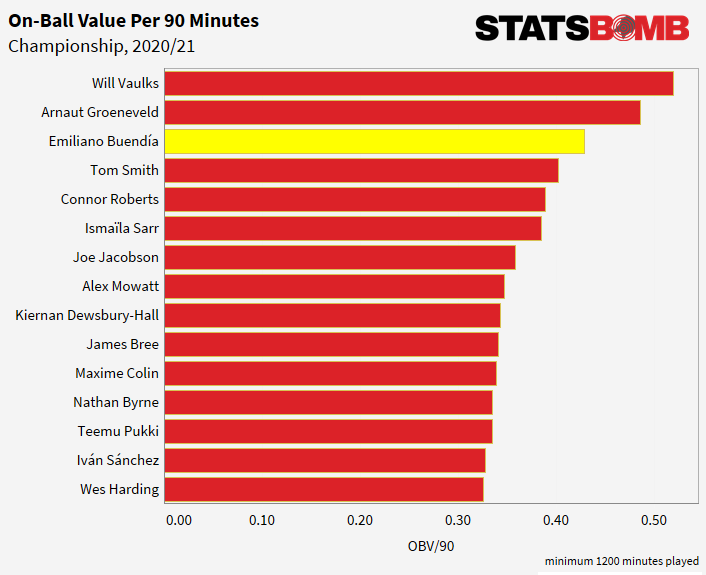 Leon Bailey is an established top-tier player on the European circuit after four seasons in the Bundesliga with Bayer Leverkusen. Last season was arguably Bailey’s strongest since moving to Germany, contributing nine goals and seven assists as Leverkusen finished 6th to qualify for the Europa League. His experience as a high performer in a big five league and on the European stage, having played in the Champions League and the Europa League, makes him an exciting prospect to evaluate.
Leon Bailey is an established top-tier player on the European circuit after four seasons in the Bundesliga with Bayer Leverkusen. Last season was arguably Bailey’s strongest since moving to Germany, contributing nine goals and seven assists as Leverkusen finished 6th to qualify for the Europa League. His experience as a high performer in a big five league and on the European stage, having played in the Champions League and the Europa League, makes him an exciting prospect to evaluate. 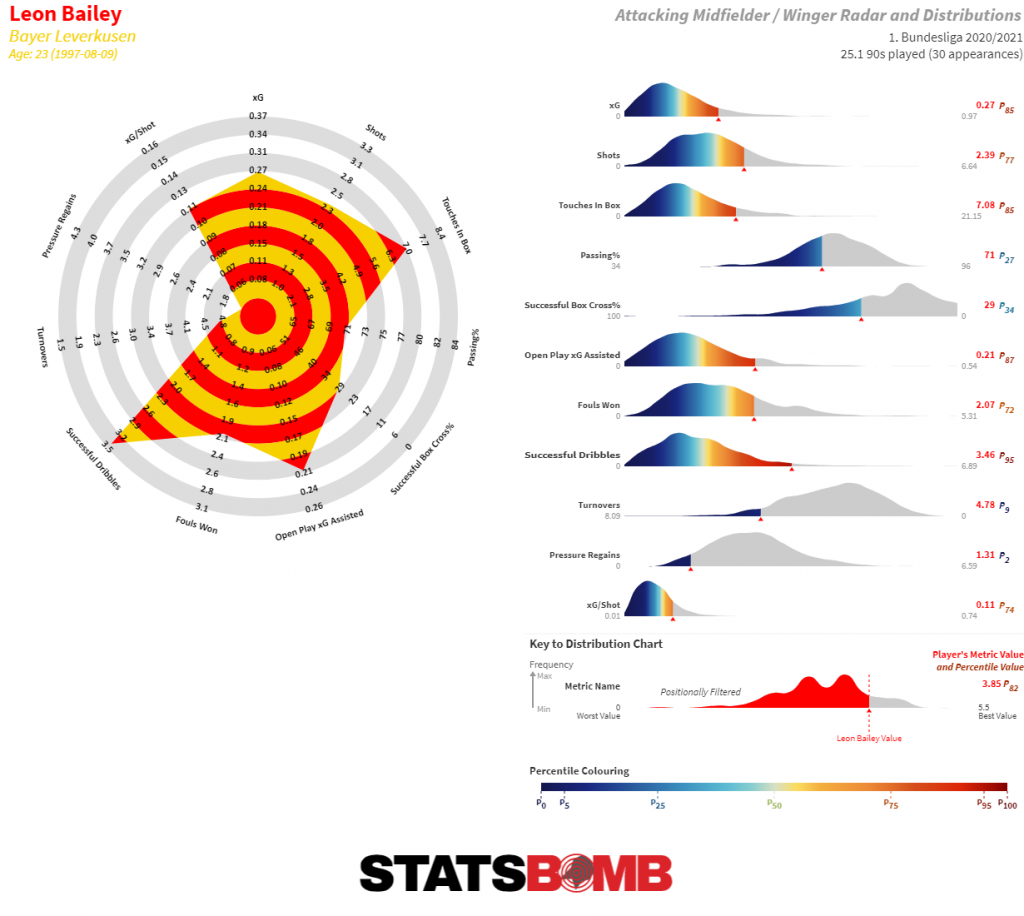 Where Buendía may provide the guile, the incisive passing, and the chance creation, Bailey’s profile leans more towards that of a dribbler and zone-mover, who can contribute goals from inside the penalty box as well. Bailey completed 3.5 dribbles per 90 in 2020/21 (5th in the Bundesliga) and had an average carry length of 6.5 metres (9th). Bailey looks like the most likely candidate to replace Grealish’s elite ball-carrying ability.
Where Buendía may provide the guile, the incisive passing, and the chance creation, Bailey’s profile leans more towards that of a dribbler and zone-mover, who can contribute goals from inside the penalty box as well. Bailey completed 3.5 dribbles per 90 in 2020/21 (5th in the Bundesliga) and had an average carry length of 6.5 metres (9th). Bailey looks like the most likely candidate to replace Grealish’s elite ball-carrying ability. 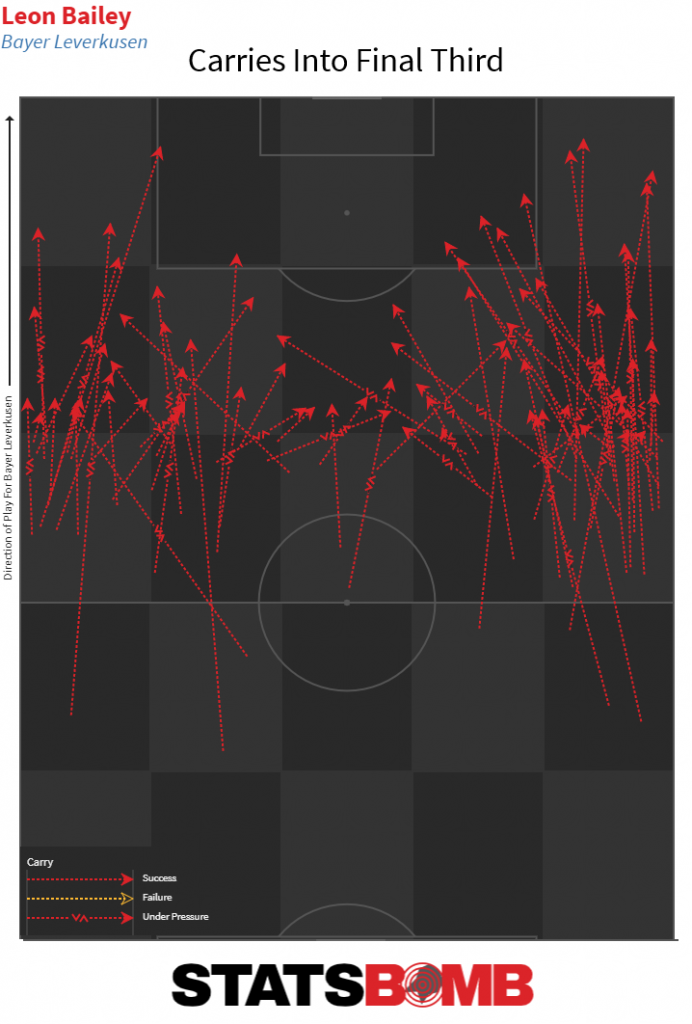 It’s also encouraging that he doesn’t seem prone to wasting possession with shots from range, his xG per shot of 0.11 is towards the higher end you’d expect from a wide forward - a trait that he appears to have had throughout his career. The third signing was that of Danny Ings, a transfer that came as a surprise to everyone except Danny Ings, Southampton, or Aston Villa. Ings is a known quantity in the Premier League so it’s obvious what he brings to the squad: work rate out of possession and a steady contribution to the Goals For column. As part of Operation Replace Jack, Ings is a less direct replacement, but should play a key role in easing the goalscoring burden placed on Ollie Watkins while also giving Dean Smith the option to play two up front. Age and injury record have been raised as possible red flags against the fee outlay, but he’s a player that you’d trust to contribute goals--as long as the new Villa setup creates chances.
It’s also encouraging that he doesn’t seem prone to wasting possession with shots from range, his xG per shot of 0.11 is towards the higher end you’d expect from a wide forward - a trait that he appears to have had throughout his career. The third signing was that of Danny Ings, a transfer that came as a surprise to everyone except Danny Ings, Southampton, or Aston Villa. Ings is a known quantity in the Premier League so it’s obvious what he brings to the squad: work rate out of possession and a steady contribution to the Goals For column. As part of Operation Replace Jack, Ings is a less direct replacement, but should play a key role in easing the goalscoring burden placed on Ollie Watkins while also giving Dean Smith the option to play two up front. Age and injury record have been raised as possible red flags against the fee outlay, but he’s a player that you’d trust to contribute goals--as long as the new Villa setup creates chances. 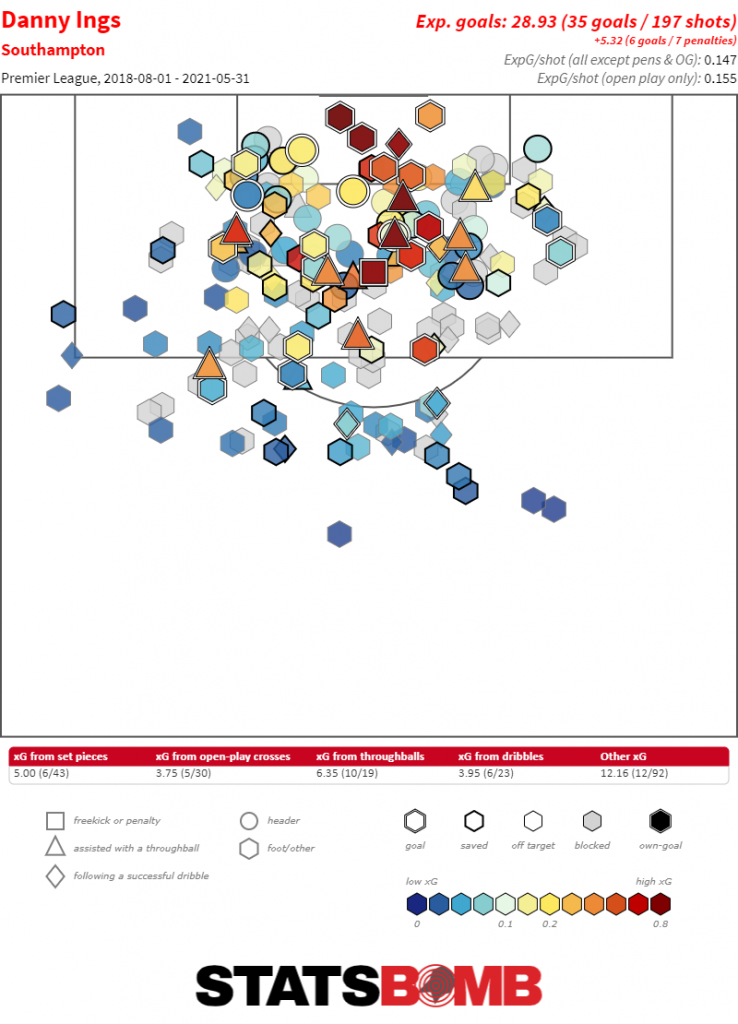 Projection So then, we await to see what happens when you take one of the best Premier League players out of a midtable side. The logic to Villa’s business is sound; they were overreliant on Grealish for several aspects of their play, and the three players should decentralise their build-up and make the team better as a whole, while also lessening the risk should injuries occur, a risk Villa are all too aware of after what happened at the end of last season. The points spreads predict a minor regression for the club, still in midtable but benchmarked at 49 points, a six-point drop-off from 2020/21. The impact of the new players is uncertain and there are valid concerns over the form Villa showed in the run-in, so this seems like a more than reasonable benchmark to aim for in season one of the regeneration. It’s important to remember that Villa spent multiple seasons in the Championship in recent history; back-to-back midtable finishes would be a sound return in establishing themselves in the Premier League once more.
Projection So then, we await to see what happens when you take one of the best Premier League players out of a midtable side. The logic to Villa’s business is sound; they were overreliant on Grealish for several aspects of their play, and the three players should decentralise their build-up and make the team better as a whole, while also lessening the risk should injuries occur, a risk Villa are all too aware of after what happened at the end of last season. The points spreads predict a minor regression for the club, still in midtable but benchmarked at 49 points, a six-point drop-off from 2020/21. The impact of the new players is uncertain and there are valid concerns over the form Villa showed in the run-in, so this seems like a more than reasonable benchmark to aim for in season one of the regeneration. It’s important to remember that Villa spent multiple seasons in the Championship in recent history; back-to-back midtable finishes would be a sound return in establishing themselves in the Premier League once more.
Want to read about another team? The rest of our Premier League season previews can be found here If you're a club, media or gambling entity and want to know more about what StatsBomb can do for you, please contact us at Sales@StatsBomb.com We also provide education in this area, so if this taste of football analytics sparked interest, check out our Introduction to Football Analytics course Follow us on Twitter in English and Spanish and also on LinkedIn
The introduction to last year's Leicester season preview reads:
It’s extremely uncharitable to take a look back at 2019-20 and declare it anything other than a success for Leicester. Yes, Champions League qualification looked likely for most of the season, and to miss out was ultimately a disappointment, but the trajectory and outcome were more than fine.
So, I guess it appears as though Leicester are destined to live out the same season over and over again, in some weird Edge of Tomorrow like fashion. Champions League qualification looked likely, they were disappointed to miss out, but the trajectory and 5th place outcome were more than fine, AND they took home an FA Cup for their troubles this time around. It’s the trajectory that counts and Leicester are certainly on the right track.
The Headline Numbers
Whilst on the surface Leicester's 5th place finish matched their 2019/20 placing, when you dig a little deeper there's actually been quite a bit of change. Firstly, the underlying numbers have taken a hit from the lofty heights they set in 2019/20 when they finished 4th for expected goal (xG) difference. Last season only Sheffield United dropped off more in this regard.
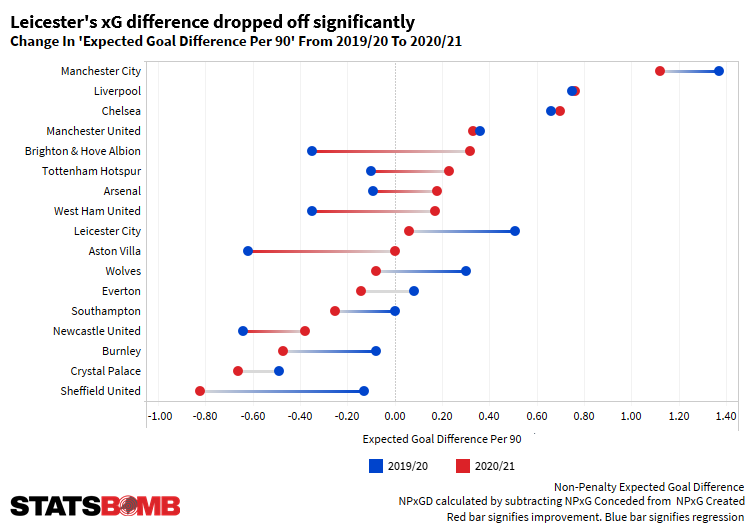
All of their overperformance came in attack. They conceded 46 goals from 46 xG, but up front scored 58 goals from 47 expected. Kelechi Iheanacho, James Maddison and Harvey Barnes ran especially hot, with Iheanacho's emergence as a reliable goalscorer in particular really helping to propel the Foxes into European contention, notching 12 goals from seven xG.
Iheanacho’s contribution was especially important given that Jamie Vardy had his first poor finishing season in four campaigns, flipping Iheanacho’s conversion rate by getting seven goals from 12 xG. Looking across the season as a whole, you can see the oh-so-difficult Christmas period that really hurt the underlying numbers, even if actual results around that period weren't so bad. Something that many teams struggled with in a particularly intense fixture schedule in 2020/21.
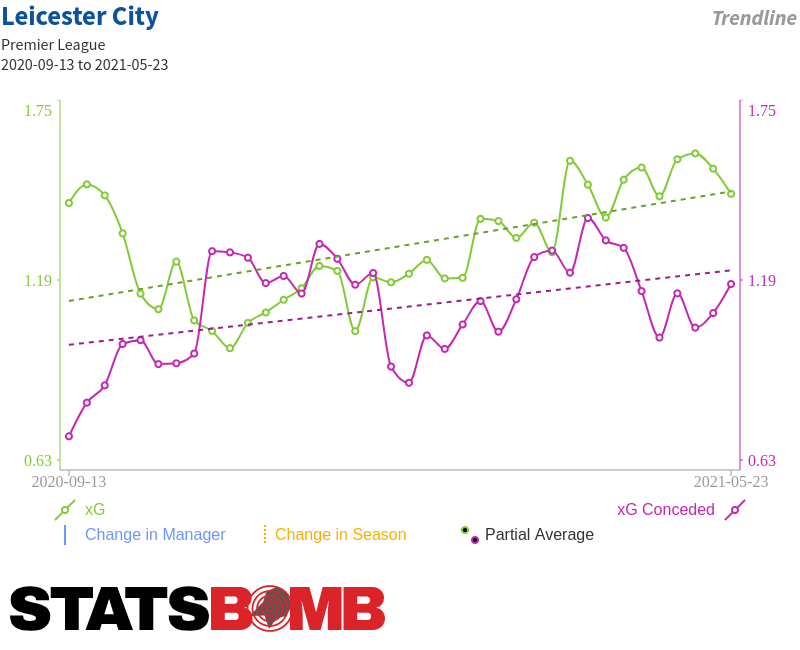
We get some interesting results when we break these xG numbers down further by looking at Leicester's xG difference during each game state.
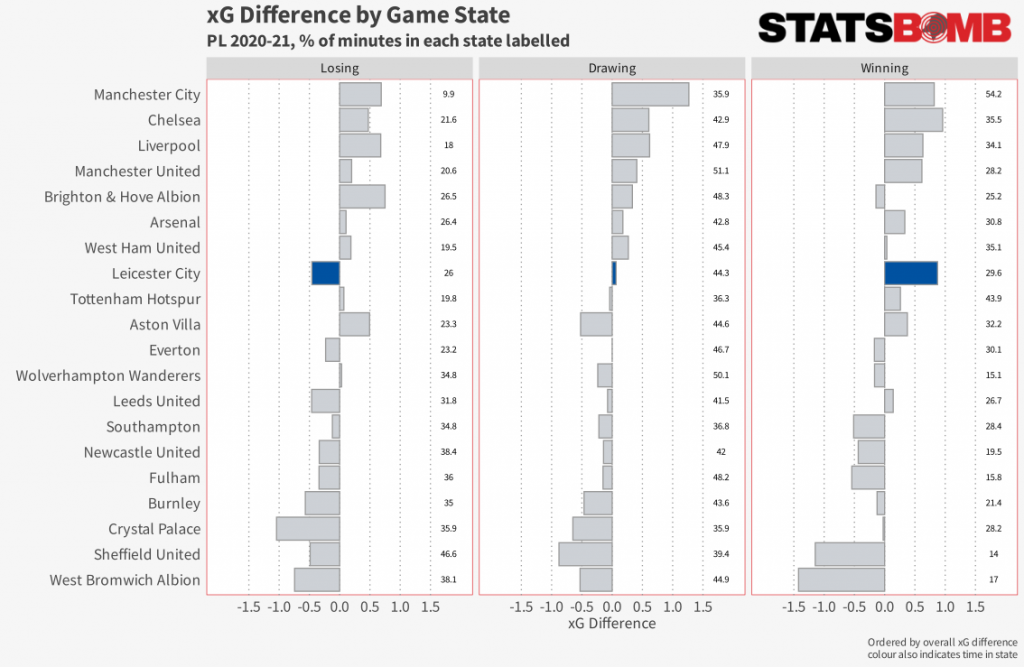
Here you can see that Leicester are an exceptional team when they're winning, which is perhaps no surprise given the attacking talents they have to play in transition and Brendan Rodgers’ track record of setting teams up to play efficiently on the break.
The squad lends itself to this approach: Vardy is notoriously great in this phase of the game, Barnes is a fantastic ball carrier at pace, and then you have Maddison and Youri Tielemans who can play the high-value pass whilst having enough mobility to stay with the play. On the other hand, Leicester really struggle when losing. They don't have trouble moving the ball into the final third - they ranked 6th for deep progressions - but keeping the ball in-and-around the box has not been a strength of theirs as they rank 13th for deep completions (successful passes within 20 meters of goal).
A large factor in their struggles when behind is that their xG per shot drops from 0.13 to 0.08, meaning they either resort to lower-quality efforts on goal or they struggle to break down teams defending a lead. Their most common pass clusters tell a similar story of ball progression, but only up to the final third. They're also quite lopsided in the opposition half - a lot of play goes through Tielemans and subsequently Iheanacho, who's much more involved than his striker partner Vardy.
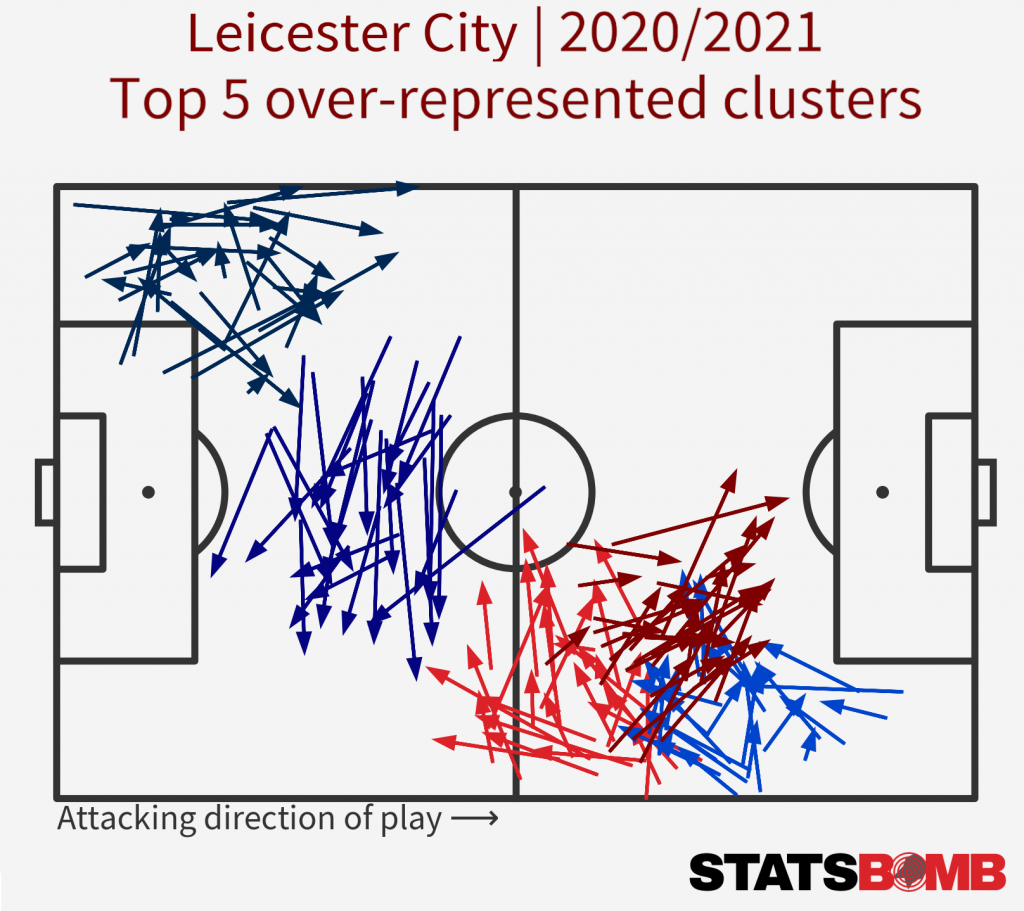
Let's dig deeper into whether those passes are providing value. Our new possession value model, On-Ball Value (OBV), rates the impact of each action on the pitch and estimates the positive or negative impact the action has on a team’s likelihood of scoring. The OBV Leicester generate across the pitch when they’re behind versus when they’re ahead is revealing:
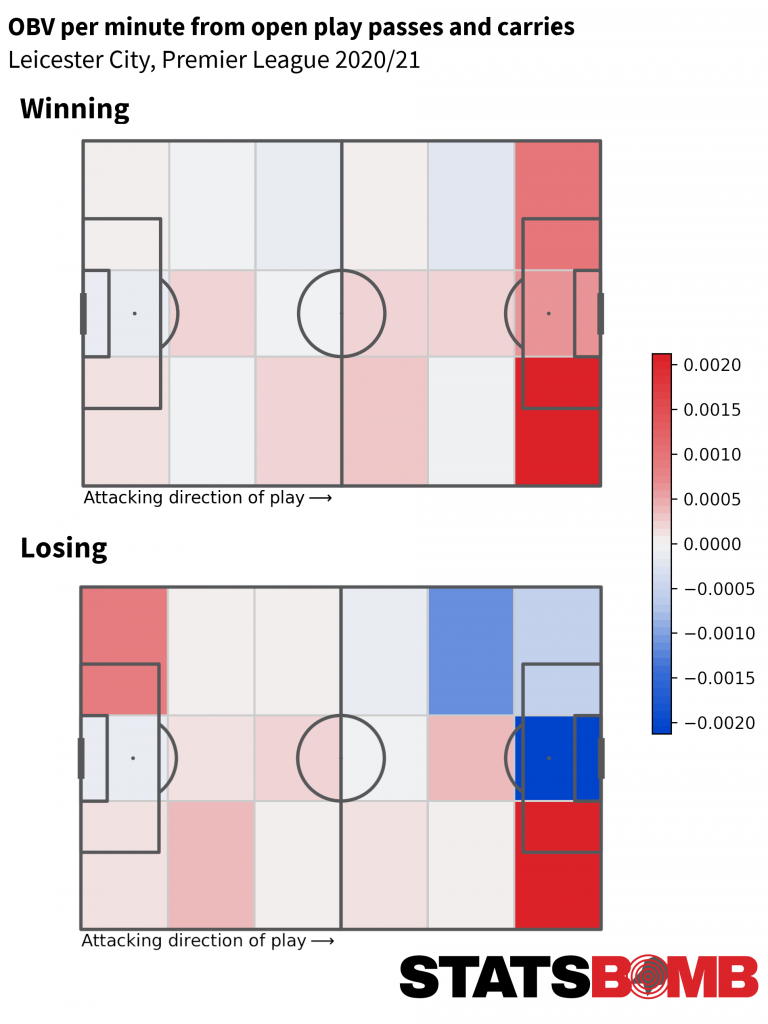
That right-sided bias is showing through again and it becomes more prominent when they're chasing the game, but they still generate plenty of OBV in deeper areas down that right-hand side regardless of game state. In contrast, the left side is a bit of a black hole when Leicester are losing - hopefully Barnes can return to his best and resolve much of this - he clocked the 16th highest OBV per 90 last season after all, for players with >900 minutes played.
Where Leicester found it difficult to create high-value chances against their opponents when behind, their opponents did not find it as difficult to create high-value chances against them. When Leicester were pushing for equalisers, their xG per shot conceded rocketed up to 0.21--their opponent's shots in this game state had a 1-in-5 chance of being converted.
The evidence suggests that Leicester struggled to manage the threat of the counter when they were pushing to get back in the game. The xG trendline also shows their xG conceded has been creeping upwards, so what's going on at the back? One explanation might be Leicester's pressing, which was down quite a bit last season.
This is despite an ongoing uptick in defensive activity since Rodgers' arrival, so it seems unlikely this was a deliberate change in approach. Leicester averaged 168 pressures per 90 in 2019-20 compared to just 135 last season. Now a lot of this will be down to the crowded schedule, and we saw pressures drop on the whole across most leagues, but Leicester appear to have suffered more than most. Here's the defensive activity maps for both seasons:
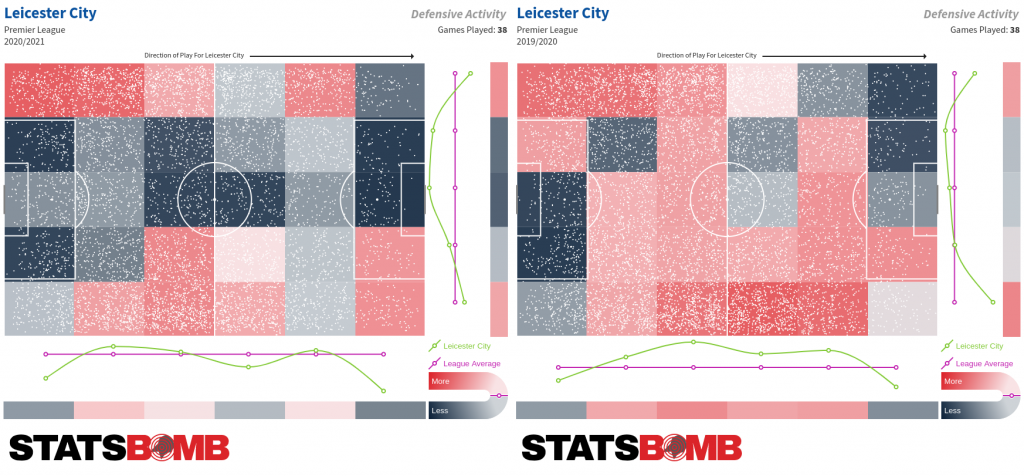
The Squad
The Foxes have developed a reputation for being shrewd operators in the transfer market, showing great patience to build the squad up again since the title-winning season. It can be difficult when squad building to balance future potential versus immediate strength, and they've executed particularly well to maintain a challenge for top four while simultaneously getting themselves into a position to continue targeting Europe for the next few years. Key players like Wilfred Ndidi, Iheanacho, Tielemans and Maddison will begin to hit their peak over the next few seasons, while Barnes, Wesley Fofana and James Justin have years ahead of them.
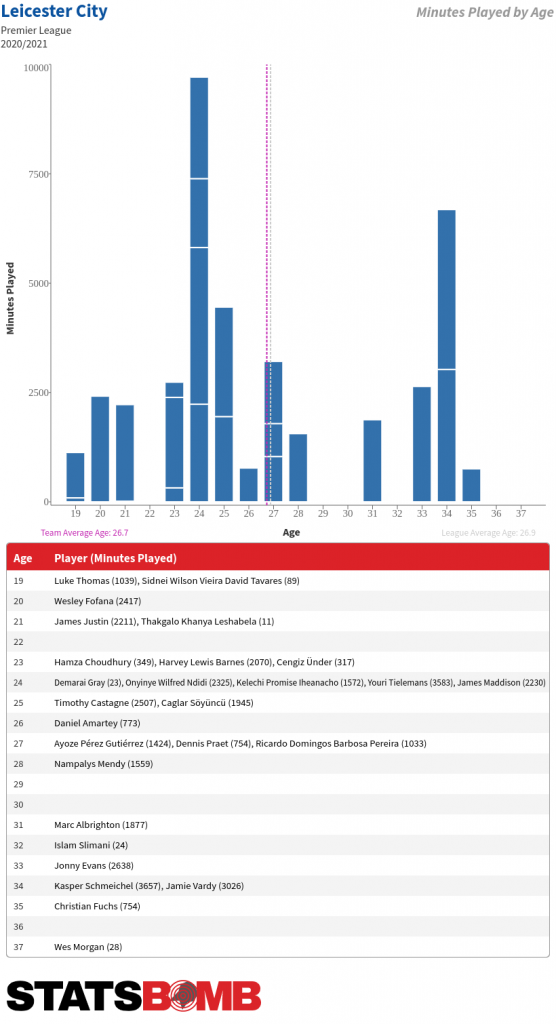
The squad was hit by some big injuries last season just as it was the season before, but it's a sign that they're operating from a solid internal process given they always have players ready to step in, whether from the academy or through recruitment.
That the forward line hasn’t needed major regeneration for a number of years is testament to Jamie Vardy’s longevity but, at 34, the time is finally getting close for him to hand the reigns over. Leicester are confident they’ve found his replacement in RB Salzburg forward Patson Daka, the big question is: is he any good?
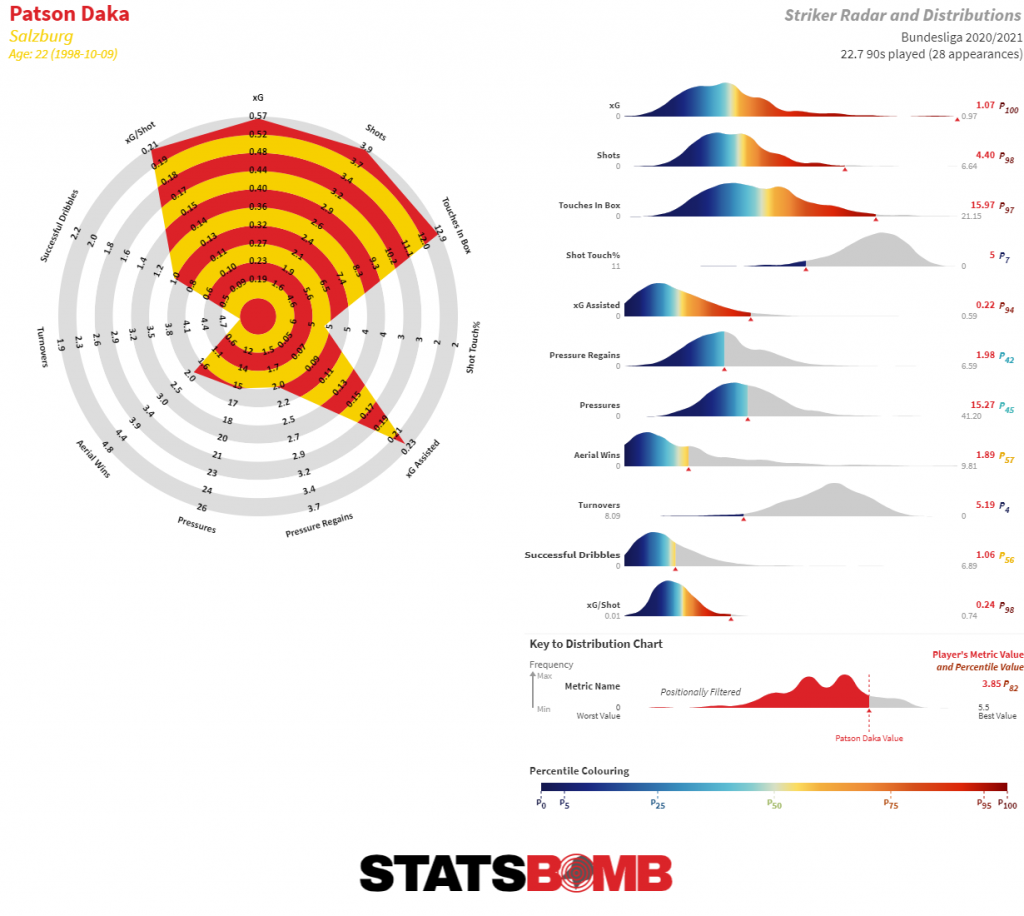
Probably! Player evaluation can be tricky when they play for a team as dominant as Salzburg are in the Austrian Bundesliga, but his numbers certainly pop. That they still pop when he plays in the Champions League is an encouraging sign, albeit the sample size gets rough.
One thing to note is that the 22-year-old shows real maturity - his shot locations are excellent and he seems to have a good understanding of his own game. Much like Vardy, he plays on the last man, is great in transition, and understands how to use his pace without the ball at his feet. It might take some time for him to find his feet, but given how Iheanacho just reminded us all that player development is rarely a smooth upward trajectory, Daka should receive plenty of slack.
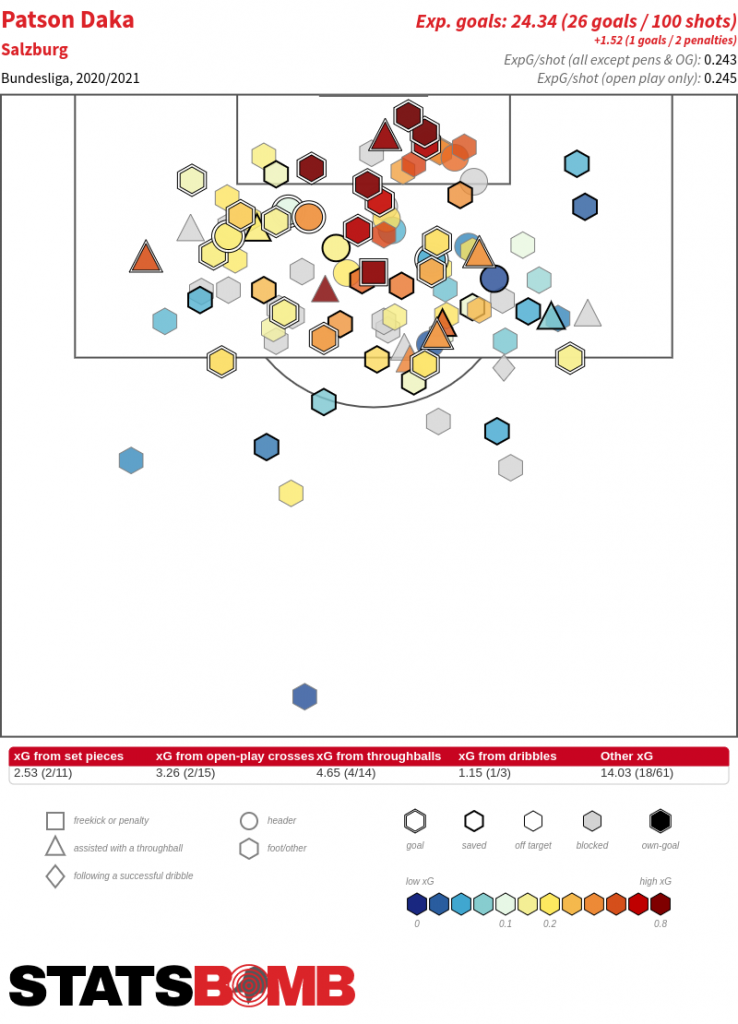
As for the other signings, it all looks very good - from the sensible in Ryan Bertrand and Jannik Vestergaard (assuming that deal gets over the line) to the downright exciting in Boubakary Soumaré.
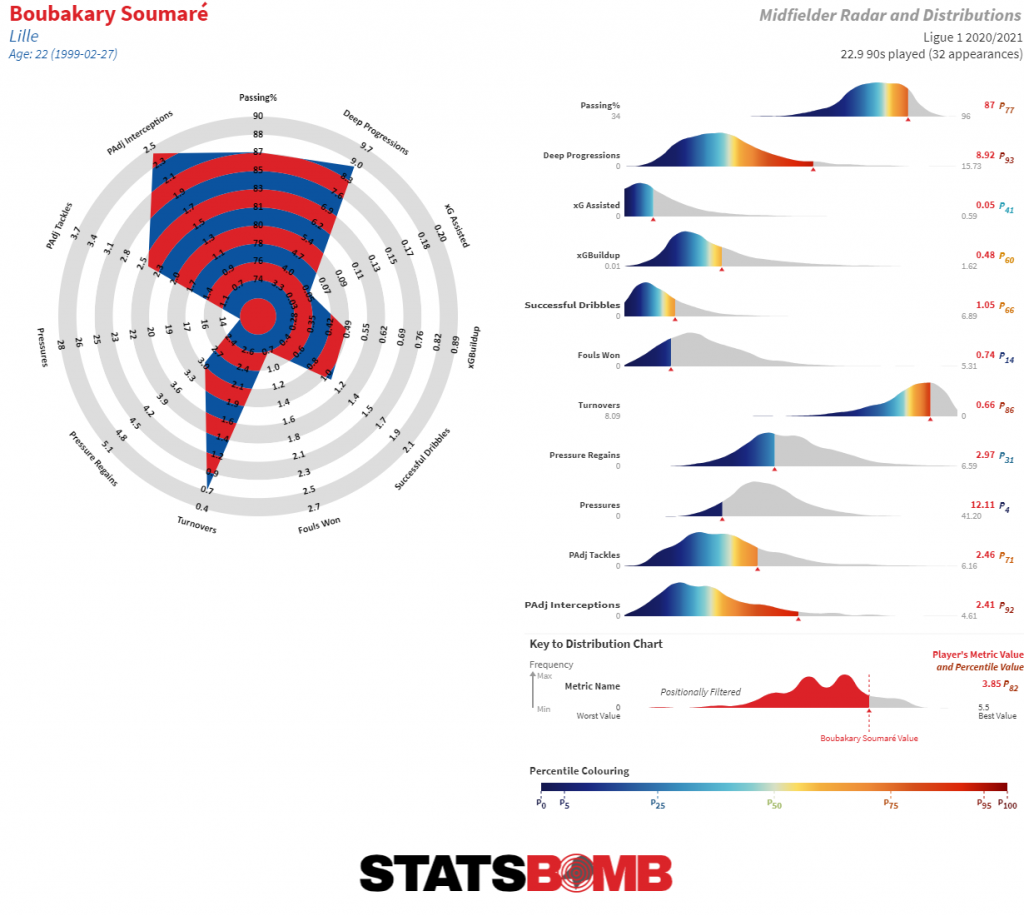
Parting Thoughts
You might be inclined to read the headline underlying numbers above and think Leicester could be in for a difficult season if they produce similar numbers to those of last season. It’s a possible outcome, but given the quality of the squad and manager, and the general outlier than last season was as a whole, it seems more likely that Leicester revert to a process that should see them knocking on the door of the Champions League places once again.
They’ve bolstered the squad with what look like top signings, and the return of Barnes should balance the attack better. As noted, we’ll need to watch out for how they perform when behind; if they continue to struggle, that could lead to dropped points that could cost them a place or two in the table. But, this team can play fantastic transition football and, with the current state of the modern game, you can go a loooong way playing great transition ball. All it takes is some better luck with injuries and one of last season's top four to have issues, and Leicester are in business.
Want to read about another team? The rest of our Premier League season previews can be found here If you're a club, media or gambling entity and want to know more about what StatsBomb can do for you, please contact us at Sales@StatsBomb.com We also provide education in this area, so if this taste of football analytics sparked interest, check out our Introduction to Football Analytics course Follow us on Twitter in English and Spanish and also on LinkedIn
First let's take a moment to salute Roy Hodgson.
From Palace youth player to retiring as Palace manager by way of a successful 45 year multi-continent managerial career, Hodgson has been a titan of the game and he will be missed, not least from the post-game interview circuit, on which he was ever good value. In truth, he leaves Palace at a good time for his legacy, as results have skewed ahead of expectation for a couple of seasons now and we can but speculate how much of a factor his veteran savvy was when placed next to landing on the right side of some statistical variance. What statistical variance would that be?
That's the expected goals for Hodgson's (nearly) four seasons in charge and here are the seasonal outcomes:

If I'm Roy Hodgson I'm pointing at the league table.
Last year I wrote that ahead of the season were Palace given the option to take 17th, they would be wise to accept. The trending in metrics season to season was bad enough that it was a valid suggestion. The team had just scored 31 goals total in a season and seen their expected numbers crater by nearly 20 goals. In reality, Palace were never really in danger of relegation--by early March they had 30+ points and were ten points clear of 18th place--while their metrics got worse, in particular further declining as they coasted in to port late on.
What was bad about 2020-21 Crystal Palace? Firstly, the defence conceded a lot of goals--66 was more than everyone bar Southampton and West Brom. Now that's a top line red flag that doesn't improve when peering beneath the surface, Vicente Guaita did have a less successful 2020-21 compared to 2019-20, but he basically kept goals out at expectation instead of buying his team an extra eight goals as he had done before. At the other end of the pitch, finally Christian Benteke scored ahead of xG (10 goals vs 8 xG) for the first time in a number of seasons and was backed up by ahead-of-xG finishing from Eberechi Eze (4 from 2) and Wilfred Zaha too (9 from 6). In attack, finally nobody bombed out. As we know, this kind of overperformance is nice to have, but impossible to rely on and technically, only Sheffield United's attack was worse.
Enter Patrick Vieira, but which one?
The Patrick Vieira that managed New York City FC initially brought a possession game to the team before transitioning towards a high energy outfit stocked with younger talents, and was relatively successful, insofar as his team competed at the top of their Conference. Upon accepting the challenge to move to Nice in 2018, it could perhaps be presumed that Vieira might pursue a similar style, but what transpired wasn't quite the same. Nice weren't unsuccessful with Vieira at the helm but at least in his first season, 2018-19, goals were super hard to come by (they scored 30, one fewer than Palace in 2019-20) and finished seventh after a raft of low scoring games. At this point the style of play was somewhat disjointed, still prioritising a passing game from the back, but not necessarily very effective with it.
Nice were a young team though and pointed upwards the following year in finishing fifth, albeit with warning signs. A season long ballooning over their non-penalty expected goal difference, which remained a steady -0.18 per game across both seasons helped but they remained a possession heavy (58% in 2018-19, 55% in 2019-20) unit with no real commitment to any kind of press and with very little functional cutting edge. His eventual dismissal in December 2020 was the result of a succession of stepped-on rakes in the form of five straight defeats in all competitions, four of which were at home, but actually coincided with metrics finally pointing upwards:
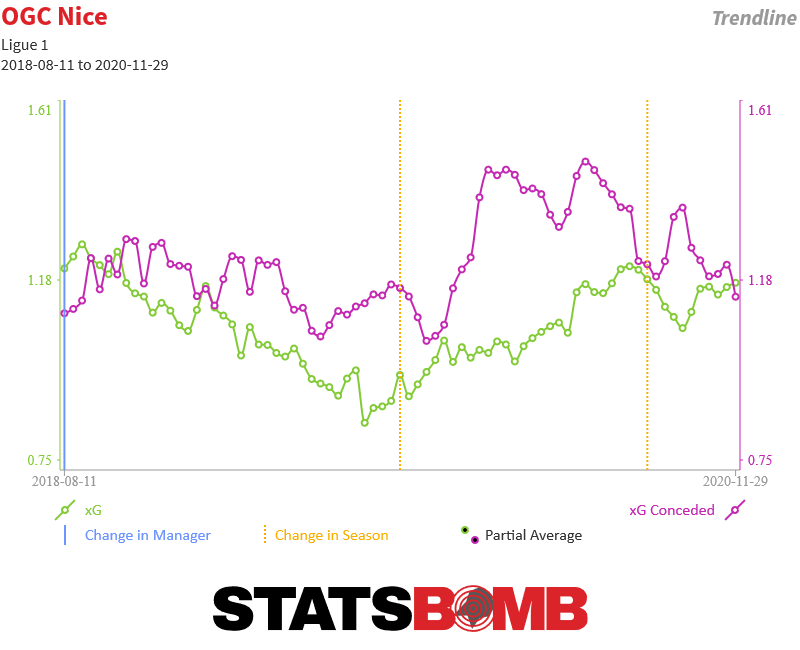
There isn't a ton to get excited about here, but sub-par metrics plus above par outcomes does speak quite loudly as to Hodgson's last two seasons, albeit via a structurally different plan. Vieira is coming in here taking over a team that has struggled recently, and it does feel a risk if he looks to deploy a possession first outlook, mainly due to the transition that will be required in this Crystal Palace team.
In recent seasons, it has escaped nobody's attention that Palace have been an aging team and their 2020 transfer window started address that with the signings of Eberechi Eze and Nathan Ferguson. Unfortunately Ferguson missed the entire season injured while a steady opening season from Eze was suffixed by an achilles injury which is thought to see him likely to miss a good portion of 2021-22. Not part of the plan, we go again!
Weirdly my preview last season included a section on Conor Gallagher which detailed how his split season across Charlton and Swansea in 2019-20 saw different aspects of his play come to the fore, and was a useful instruction to factoring in team styles into player evaluation. He then rocked up at West Brom and found similar divergence playing first for Slaven Bilić and then for Big Sam Allardyce, each of which meant that his statistical profile once more varied:
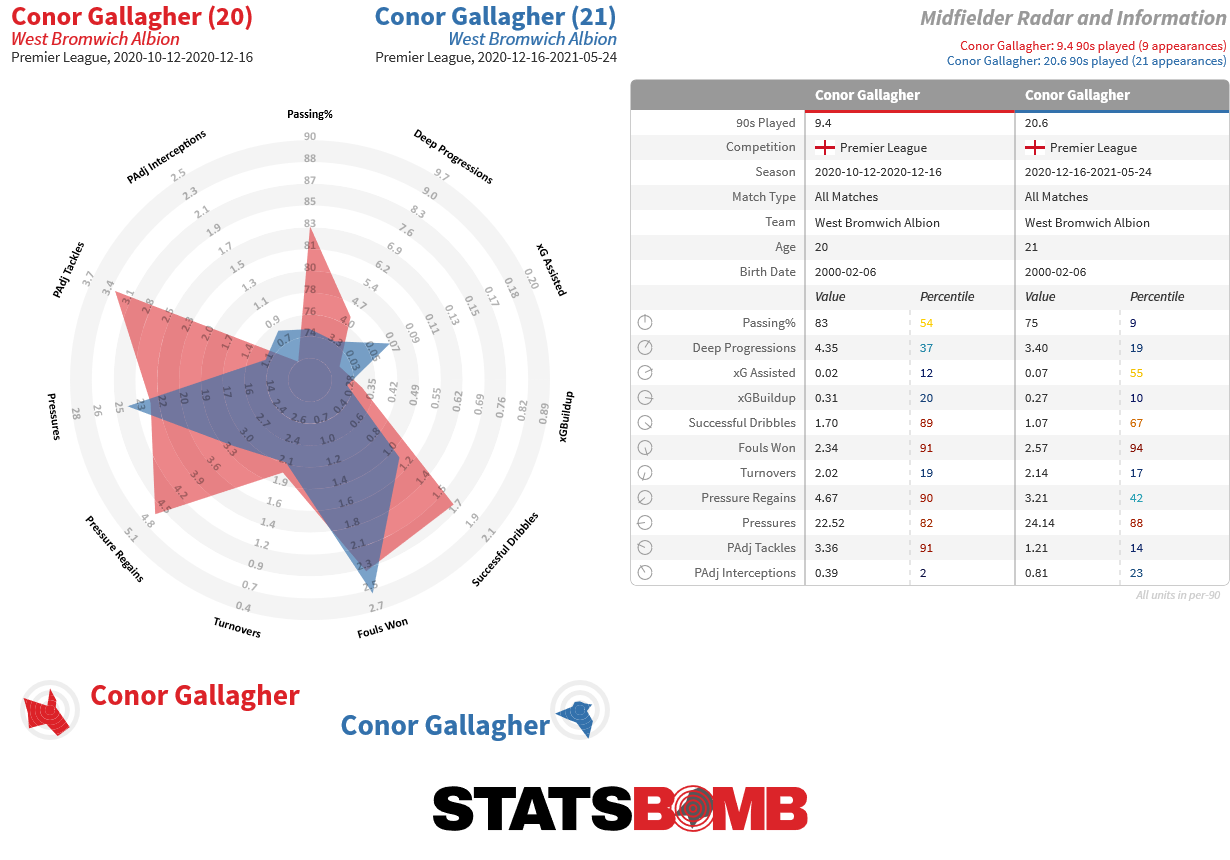
It paints a mixed picture, but is pretty positive for a young player in their first season in the league on a relegated team. The guy who logged 83% pass completion for Bilić will fit in nicely to Vieira's plans, the 75% guy who played for Allardyce perhaps less so.
Elsewhere, the proverbial chequebook has come out for some promising talent in Reading's Michael Olise and Chelsea's Marc Guéhi, who impressed on loan at Swansea last season and is likely ready for a step up in league. Both these signings look ideal, talented young players ready for the next step in their career, but the caution is in the entire squad profile. Palace's rebuild appears to have come a little late, and as such the squad skews away from the age group it likely needs to--prime.
The one signing that sits bang on the line here is that of Joachim Anderson, another player who spent 2020-21 on loan at a relegated side (this time Fulham) while performing not without credit. He was linked with Tottenham earlier in the summer and can viably be considered a coup for Palace. Guéhi and Anderson likely slot right in at left and right centre back especially give that the 1-2-3 2020-21 depth at left centre back (Gary Cahill, Scott Dann and Mamadou Sakho) have all departed and right centre back was mainly manned by Cheikhou Kouyaté, who may be a centre back now but certainly wasn't always.
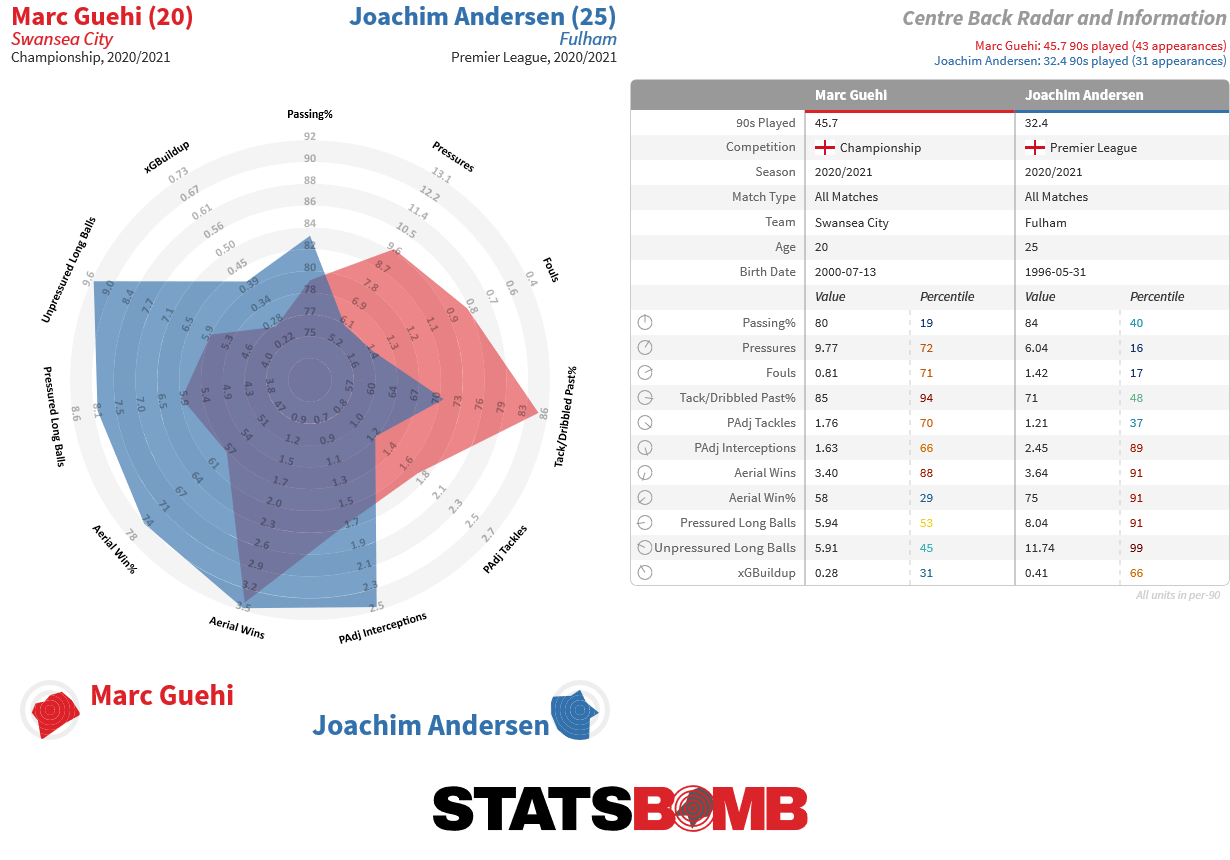
A slew of contracts ended for Palace in the summer of 2021 and in particular, departures from long term veterans and regular performers such as Andros Townsend and Patrick van Aanholt mean the squad currently looks light overall, with a particular deficiency in midfield. Of course the transfer window is open a while yet so remedial action may be taken, but it appears likely that Palace will start the season without a strong bench. It's possible that Palace are waiting for the music to stop elsewhere and planning to offer regular playing time to some of the top clubs less wanted stars, and that's certainly a strategy that may bear fruit.
Projection
Squad turnover and thinness, a lack of prime age players, a new manager likely to change the style of play and long term sub-par metrics all point at risk factors ahead of 2021-22. Palace have rightly been praised for some of their moves in this window for addressing their long term future, but they still need to stay in this league in the present to benefit from those moves and that may prove tough. Last season's projection was thus:
The trending is wrong and it will take distinct and real change to the team's metrics to give them a chance of steering clear of a relegation battle. Hodgson has been in the game long enough to see the warning signs and in most Premier League seasons there are double the amount of teams that perform at a level to put themselves into the relegation mix, so he may like the chances of winning a coin flip. But planning and execution of strategy are what limit risks such as this, and having been reactive rather than proactive in turning over their squad it could well be tough for the club. Offered seventeenth today, you'd have to take it.
In truth very similar remarks apply now. The bookmakers have Palace, Brentford, Norwich, Watford, Burnley and Newcastle in the mix for sub-40 points at this juncture, meaning once more a likely six teams for three relegation spots, the same either/or dynamic as last season. This end of the table is a new challenge for Vieira and he will need all his man management skills to get the best from this squad, week in, week out and keep them competitive. Offered seventeenth today, they should take it.
Want to read about another team? The rest of our Premier League season previews can be found here
If you're a club, media or gambling entity and want to know more about what StatsBomb can do for you, please contact us at Sales@StatsBomb.com
We also provide education in this area, so if this taste of football analytics sparked interest, check out our Introduction to Football Analytics course
Follow us on Twitter in English and Spanish and also on LinkedIn
There was a point in the last couple of seasons where Brentford’s eventual promotion to the Premier League upgraded from a strong possibility to a complete inevitability. Pedants will point to 4:55 pm on 29th May 2021, the moment Chris Kavanagh put the whistle to his lips to bring the curtain down on the play-off final victory over Swansea, but for many the realisation came months, if not years, earlier.
How many times have we seen Brentford lose a vital member of their squad over the last few seasons?
Players regarded as some of the best the Championship had to offer, let alone the Brentford XI, whose departures unquestionably weakened the squad? The names roll off the tongue: Gray, Tarkowski, Hogan, Woods, Colin, Jota, Egan, Mepham, Konsa, Maupay, Benrahma, Watkins. Each were sold for millions, sometimes tens of millions of pounds, and represented a substantial loss to a team with promotion ideas.
Or at least they would’ve meant a substantial loss to other, less smart teams. But this was all part of the process for Brentford. The consistency with which the Bees would simply get harder, better, faster*, stronger (not always faster, Scott Hogan had some meeps) after selling a high-quality footballer was as impressive as it was daunting for their competition.
The funny thing about it? Brentford more or less told everyone what they were doing, and executed anyway. It’s one thing to identify an edge or three, but to then give your rivals a big clue as to what you’re up to and how you’re going about it, before gesturing a friendly wave at them in the rearview mirror as you speed past, is another. The steely bullishness of the club initially drew scorn from some quarters who turned their nose up at it early on, but scorn was soon replaced by curiosity, and curiosity soon replaced with acclaim.
The evolution towards the team they have now was an interesting road that took many seasons, and lessons were clearly learned along the way. Under Dean Smith, the team was young and volatile; wild swings in form and turbulence in results were a common trend. As Thomas Frank came in, the recruitment strategy turned towards a more rounded blend of age and experience. In the 2020/21 promotion season, the squad saw an almost perfect allocation of minutes; a sprinkling of youthful exuberance, a heavy dose of peak-age ability, and a select few wise old heads to steer the on-pitch ship.
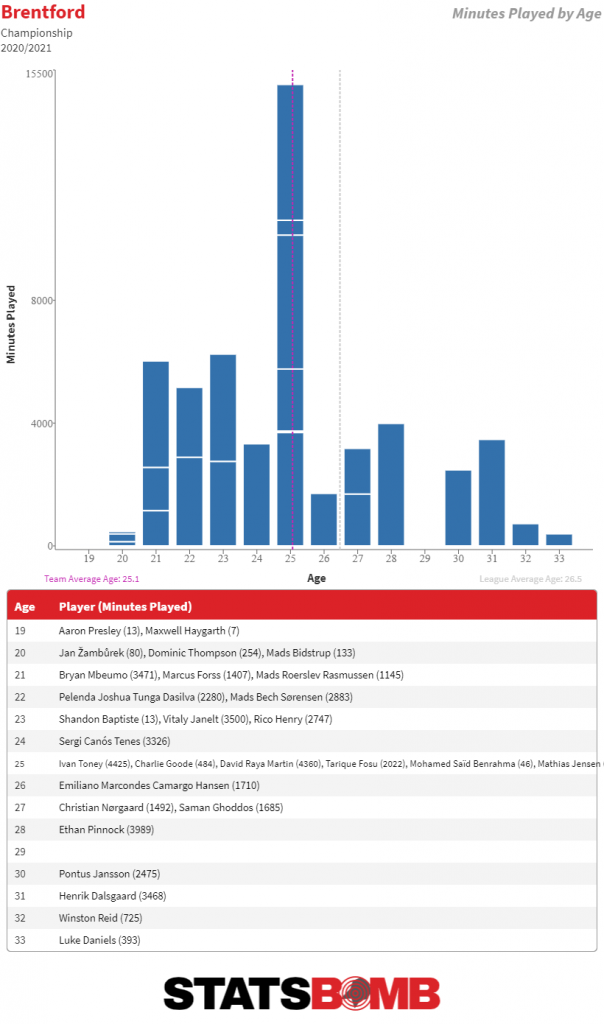
The makeup of the squad, and Thomas Frank’s tactical evolution of the side, started to steady what were previously unstable results. Brentford were prone to streaks of both positive and negative form under Dean Smith. They’d be playing great football and looking like one of the best sides in the league in one month, and the next be exposed repeatedly in defence with the team looking unbalanced towards attacking flair. Frank took a while to get his ideas across, but there’s no arguing with the process or the results in his two full seasons in charge.
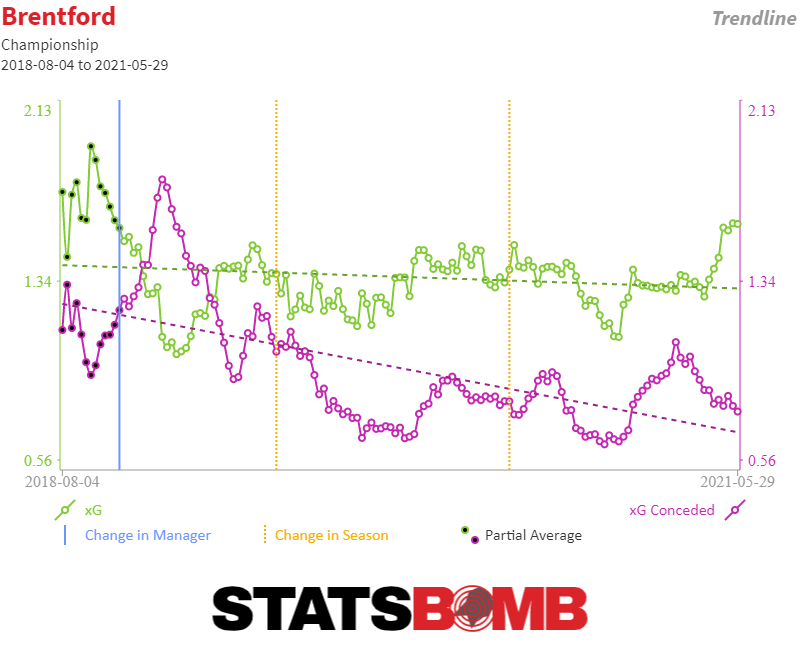
Frank was a member of the coaching staff under Smith and took over the hotseat in October 2018 when Smith departed for boyhood club Aston Villa. It created an interesting dynamic: he clearly would’ve been involved in the implementation and drilling of the game model under Smith, but also must’ve been watching with some clear ideas of his own as to how the team could improve.
There were very subtle changes in the team’s attacking output; the team became more open to crossing the ball and attacked with slightly more pace, but process and outcomes more or less remained the same.
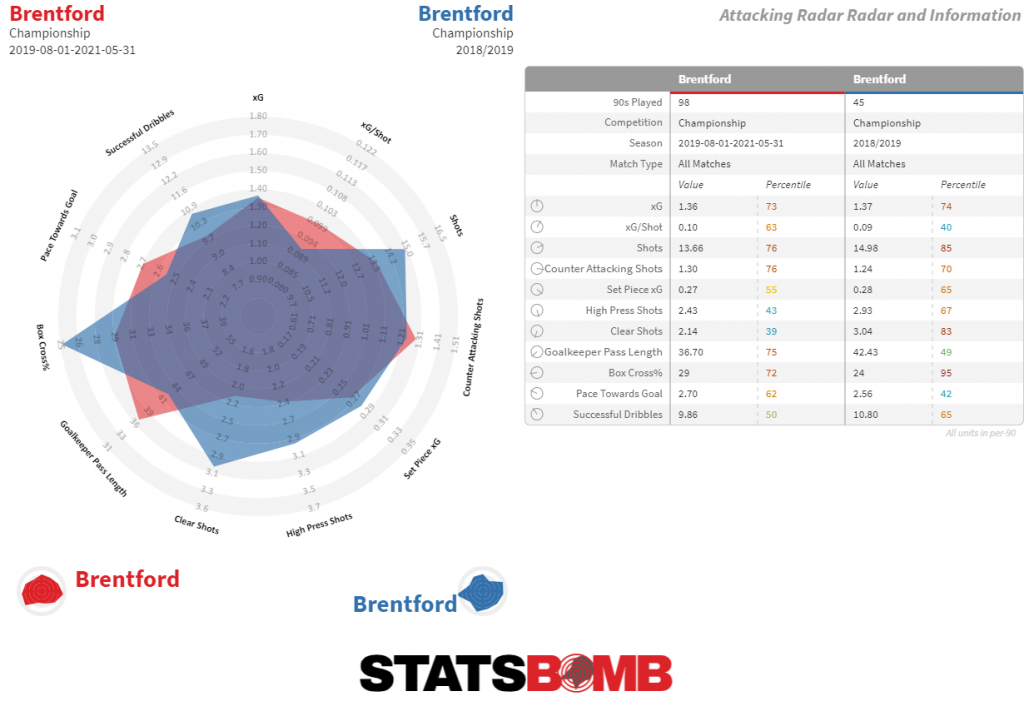
But it was on the defensive end where Frank made a huge difference and clearly demonstrated that he can coach a more effective defence than Smith, or at least the Smith that was at Brentford. Under Smith, the Bees earned a deserved reputation for playing free-flowing, attacking football in the Championship, a draw for the many talented attackers they recruited in the Matthew Benham era. But the factor that finally earned them promotion was developing a league-best defensive process. Only Leeds conceded fewer expected goals (xG) than Brentford in 2019/20--no one bettered them in 2020/21.
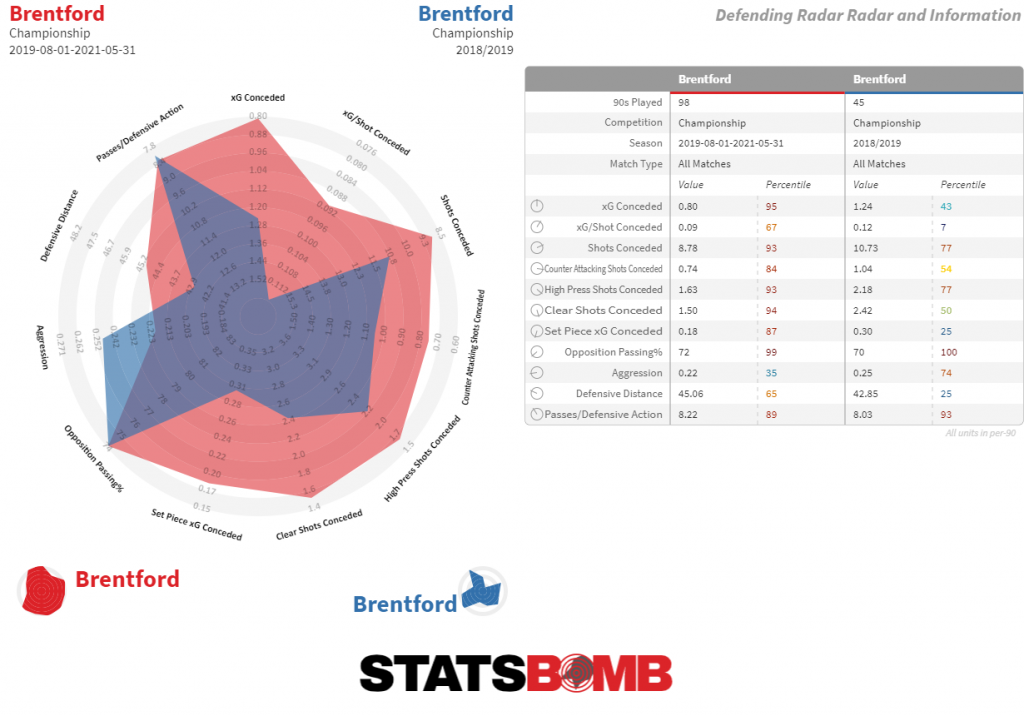
The thing about the promotion-winning Brentford side was that they were good at… well, everything. Pick a metric, Brentford were within touching distance of the top of it at both ends of the pitch. This was a team with many strengths and very few, quite honestly any, weaknesses.
| Metric (per 90 minutes) | For | Against |
| Expected Goals | 1.40 (2nd) | 0.79 (1st) |
| Shots | 13.2 (3rd) | 8.4 (1st) |
| Counter Attacking Shots | 1.1 (3rd) | 0.6 (5th) |
| High Press Shots | 2.2 (3rd) | 1.3 (4th) |
| 1 v 1 Shots* | 2.4 (2nd) | 1.3 (2nd) |
| Set-Piece Goals | 0.27 (8th) | 0.18 (5th) |
| Final Third Entries | 38.1 (7th) | 34.9 (5th) |
| Passes Inside The Box | 3.2 (2nd) | 1.6 (1st) |
*Shots with just the goalkeeper between ball and goal
They could hurt you on the counterattack, but you couldn’t hurt them back. They could press you high and turn the ball over, but they’d just play through you if you tried to do the same. They regularly created clear chances on goal, but you always found an outstretched Ethan Pinnock leg in the way when you caught a rare glimpse of the net. They’d bully you from set-pieces, but David Raya was always there to punch yours away. They found it easy to pass their way through your defensive setup and reach dangerous territory, but you’d be doing well if you completed two passes in Brentford’s penalty area in a game.
The irony won’t be lost on anyone – least of all Benham and his staff – that Brentford were automatic promotion candidates in each of the last two seasons according to the expected goals “table of justice”, but fell short on both occasions to land in a play-off spot in the real-life-football-is-played-on-grass-not-spreadsheets table. Brentford had the 2nd best expected goal difference in 2019/20 - many observers felt they deserved to go up that year - but they fell short in the last half an hour of the season, losing in play-off final extra time to Fulham.
They must’ve feared a similar outcome this season when they were again 2nd-best in the expected goals table, this time just behind Norwich, and were again favourites in the play-off final, this time against Swansea. They needn't have worried. The game could hardly have started any better to settle the nerves. An early Ivan Toney penalty ten minutes into the game, followed by a lightning-quick, smooth and slick counterattack to put them 2-0 up midway through the first half was enough to see off Swansea, who never really came within touching distance after that.
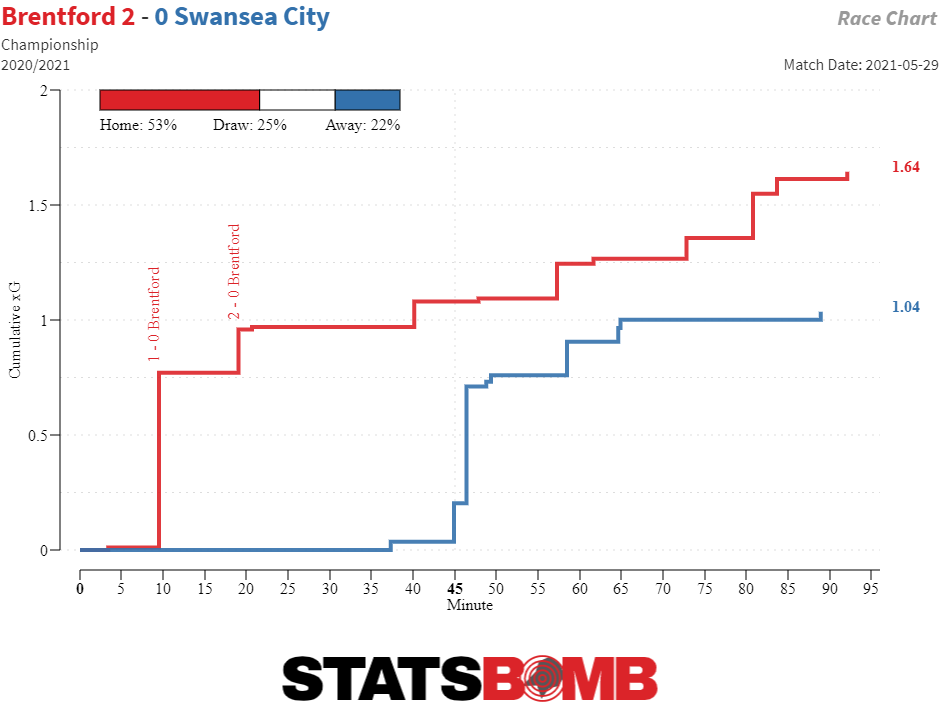
So what to expect in the Premier League? Gut instinct says that the same calm serenity that comes from the top of the club will remain, enabling Frank and his team to attack the division as they see fit, likely taking a pragmatic approach to each individual challenge; sometimes taking the game to the opponent, other times hoping to nick a draw or win with carefully selected counterattacking opportunities.
Two bits of their summer business, in particular, give strong clues as to the areas of the game they’ll be prioritising in their maiden Premier League outing. Frank Onyeka’s arrival from FC Midtjylland adds depth to the central midfield, particularly with news of Josh Dasilva’s struggles to get fit. When Dasilva broke down in February, it was clear that Brentford missed his ability to dribble the ball through the midfield, weaving through challenges as he carried the ball into the final third. Dasilva was second only to Mathias Jensen for the number of passes and carries made into the final third on a per 90 minute basis - ball progression from the middle third was an area they needed to strengthen this summer and Onyeka’s profile is not dissimilar to that of Dasilva’s.
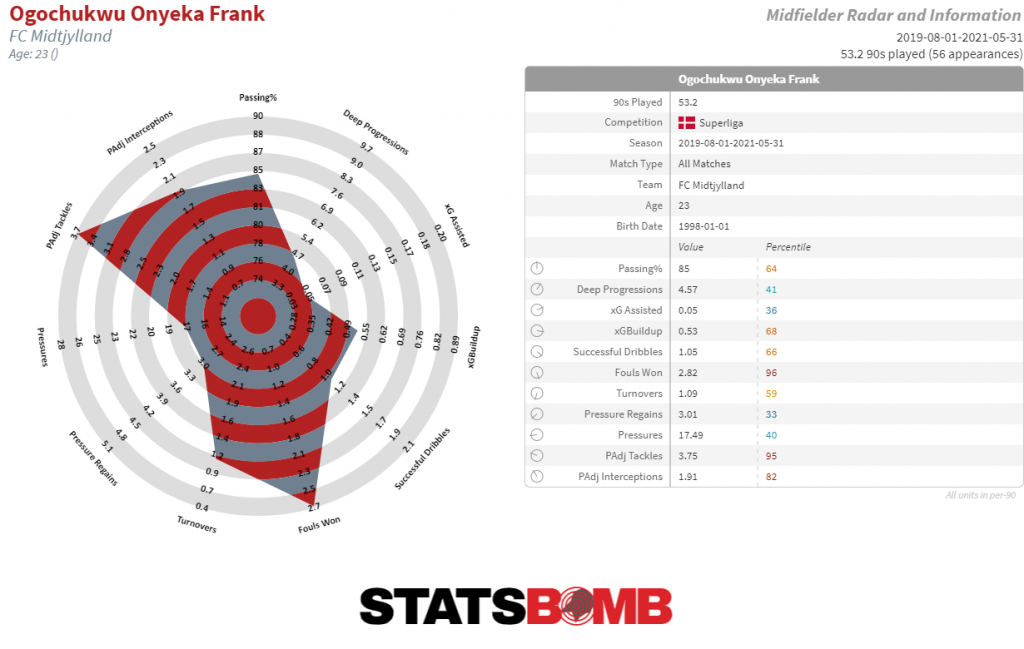
Judging by Onyeka’s profile, he’ll bring a similar ability on the ball and there are strong indicators that the 23-year-old will be able to cope with the intense pressure and physicality that comes in a Premier League midfield battle. Being able to retain the ball under pressure will be key if Brentford are to continue to play through the thirds and execute swift counterattacks. Onyeka won 2.7 fouls per 90 minutes last season (2nd amongst Danish Super Liga central midfielders) and turned the ball over just 1.3 times per game, bringing a press resistance and drive to the centre of Brentford’s midfield that’s lacking without Dasilva. It helps that Onyeka is a capable and regular contributor to the defensive side of the ball as well.
The second key signing is that of Yoane Wissa from Lorient. Wissa signs after a six-goal + four assists (not including penalties) season in Ligue 1 after establishing himself as one of Ligue 2’s best wide forwards in the two seasons prior. We all know how effective Brentford have been at shopping for the best attacking talents in Ligue 2 before – Neal Maupay and Saïd Benrahma were sold for nearly £50 million to Premier League clubs, and Bryan Mbeumo is regarded as every bit as talented as those two. Who’d bet against Wissa replicating that success, albeit at a higher level?
Wissa profiles like a goalscoring wide forward with an ability to get on the end of close-range chances in the box. His data profile is encouraging, contributing 0.40 xG & xG Assisted per 90 minutes for a side that finished 16th in the table, and in a league that has traditionally translated well to the Premier League.
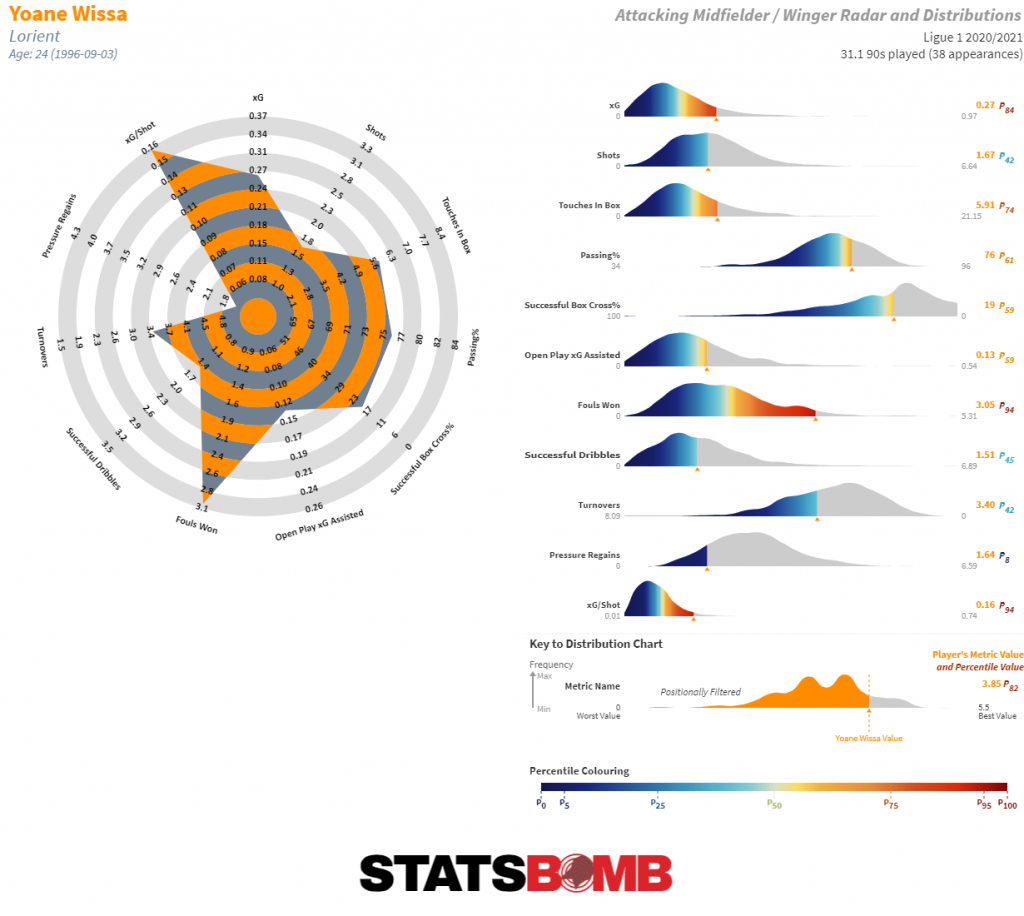
The Congolese forward clearly favours shot quality over shot quantity with an xG per shot of 0.16, meaning we could expect a goal roughy every six shots from him. It wouldn’t be a surprise to see him and 33-goal Ivan Toney battling to tap in the numerous loose balls that Brentford seem to so consistently generate around the six-yard box. Toney may not like it, but it can only be a good thing for Brentford.
What does Wissa’s profile have in common with Onyeka? Fouls won. Wissa drew 3.1 fouls per 90 last season, fourth in Ligue 1 for attacking midfielders and wingers. The prominence of both Onyeka and Wissa’s foul winning rates leads to a suspicion that this may be a deliberate ploy to draw more set-piece opportunities in a season where Brentford may have to lean on them for goalscoring chances… we will have to wait and see.
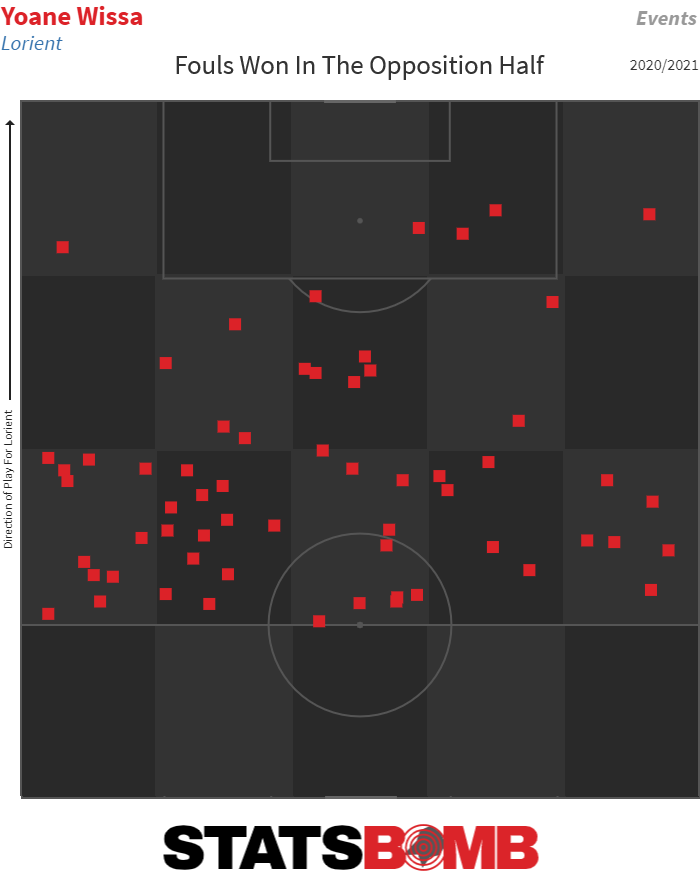
The other incoming to date is that of Kristoffer Ajer from Celtic, a move seen as something of a coup given the Norwegian has been linked with clubs much higher in the food chain than Brentford in recent seasons. After a season in which Celtic’s stock fell, Brentford took advantage to add a pacey and technical ball-playing centre back to their ranks and a player who looks like a great complement to the aerial and defensive skillsets of Pontus Jansson and Ethan Pinnock. Could Brentford’s plan A be the same 3-5-2 they deployed towards the end of last season?
Projection
Something that may surprise fans and Premier League observers is that the betting markets rate Brentford as the strongest of the three promoted sides. To those that keep an eye on these things, it’ll be less surprising—Brentford were consistently one of the promotion favourites in the Championship for several consecutive seasons before they actually got over the line. Their underlying numbers plus general reputation for being canny operators mean that the markets have a lot more confidence in them than you’d perhaps expect for a side playing top-tier football for the first time in 74 years.
The Bees will hope that there’ll be three sides worse off points-wise than them come May - their fellow promoted clubs plus Crystal Palace, Newcastle, and Burnley are seen as their main competition. Clubs that have perennially struggled at the bottom of the Premier League should be wary of the fact that Brentford now have a Premier League budget on which to execute what they’ve demonstrated time and time again is a highly effective blueprint. Even if they don’t quite pull it off, you can’t help but feel this is only the beginning of Brentford’s longer-term Premier League journey.
Want to read about another team? The rest of our Premier League season previews can be found here
If you're a club, media or gambling entity and want to know more about what StatsBomb can do for you, please contact us at Sales@StatsBomb.com
We also provide education in this area, so if this taste of football analytics sparked interest, check out our Introduction to Football Analytics course
Follow us on Twitter in English and Spanish and also on LinkedIn
